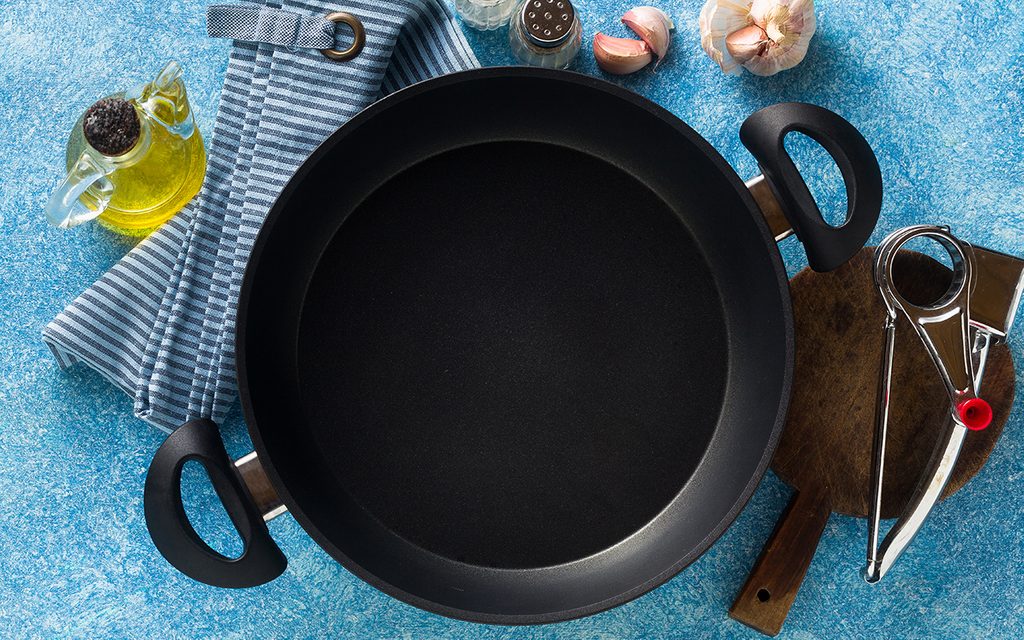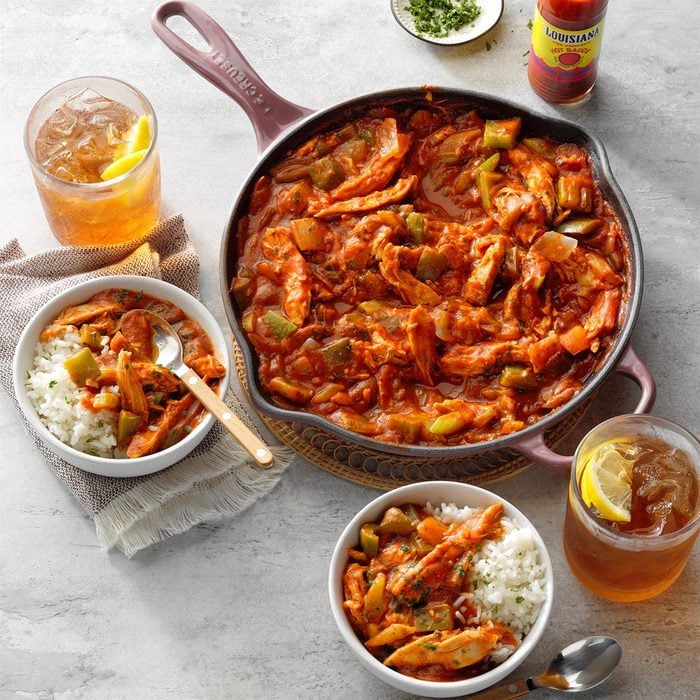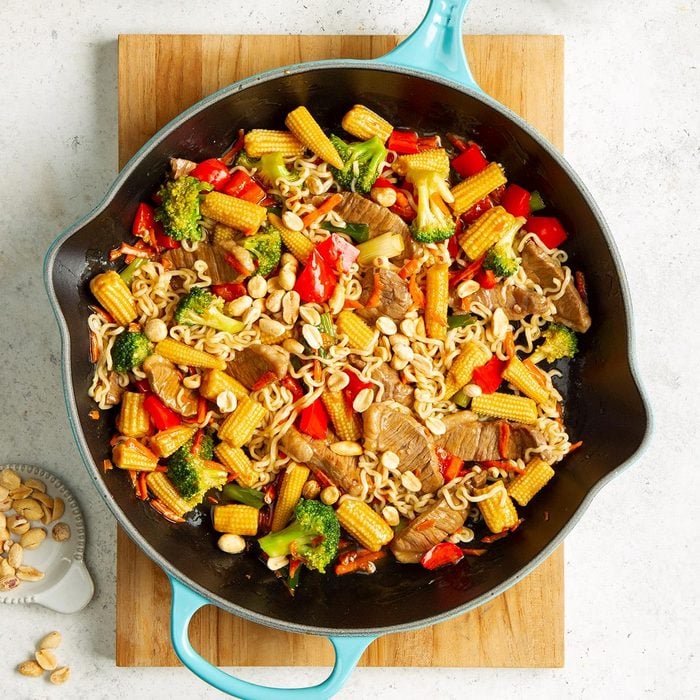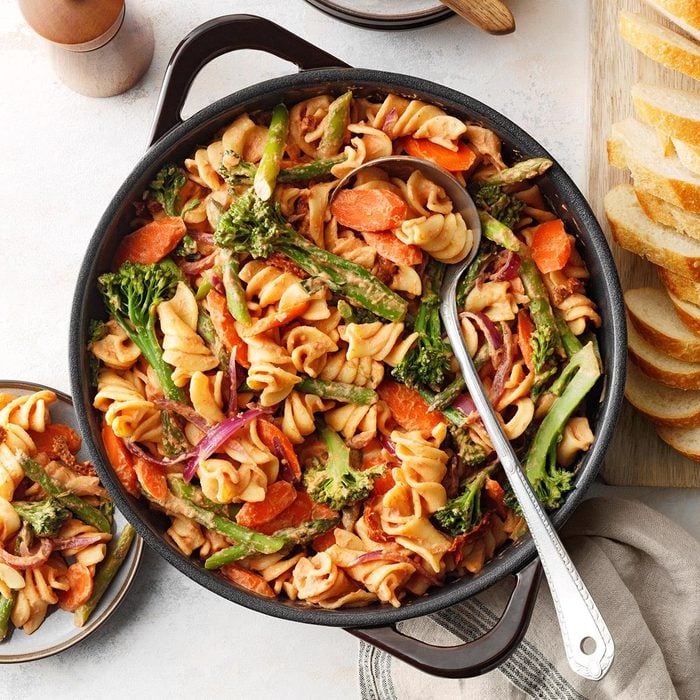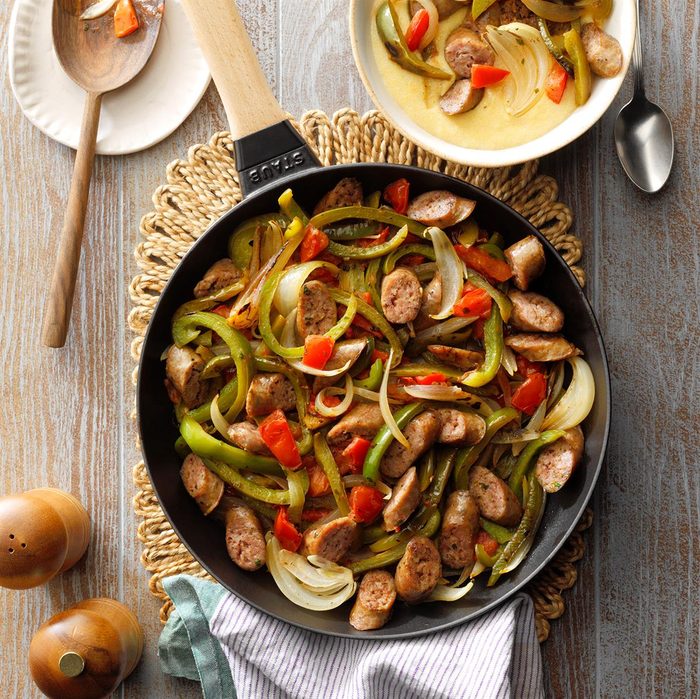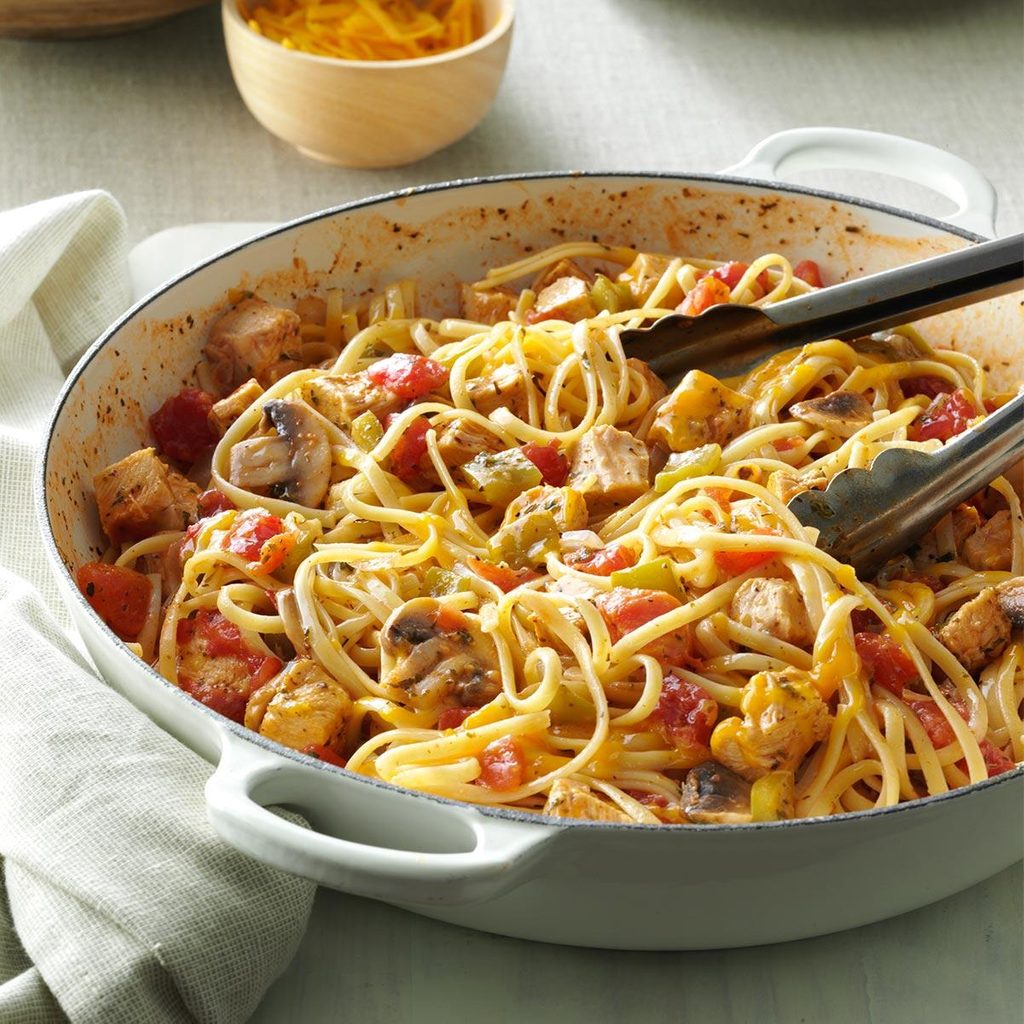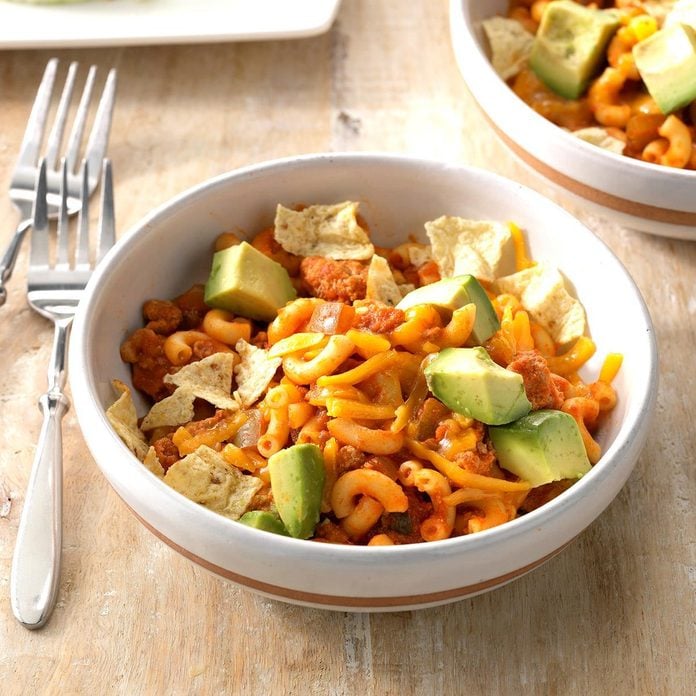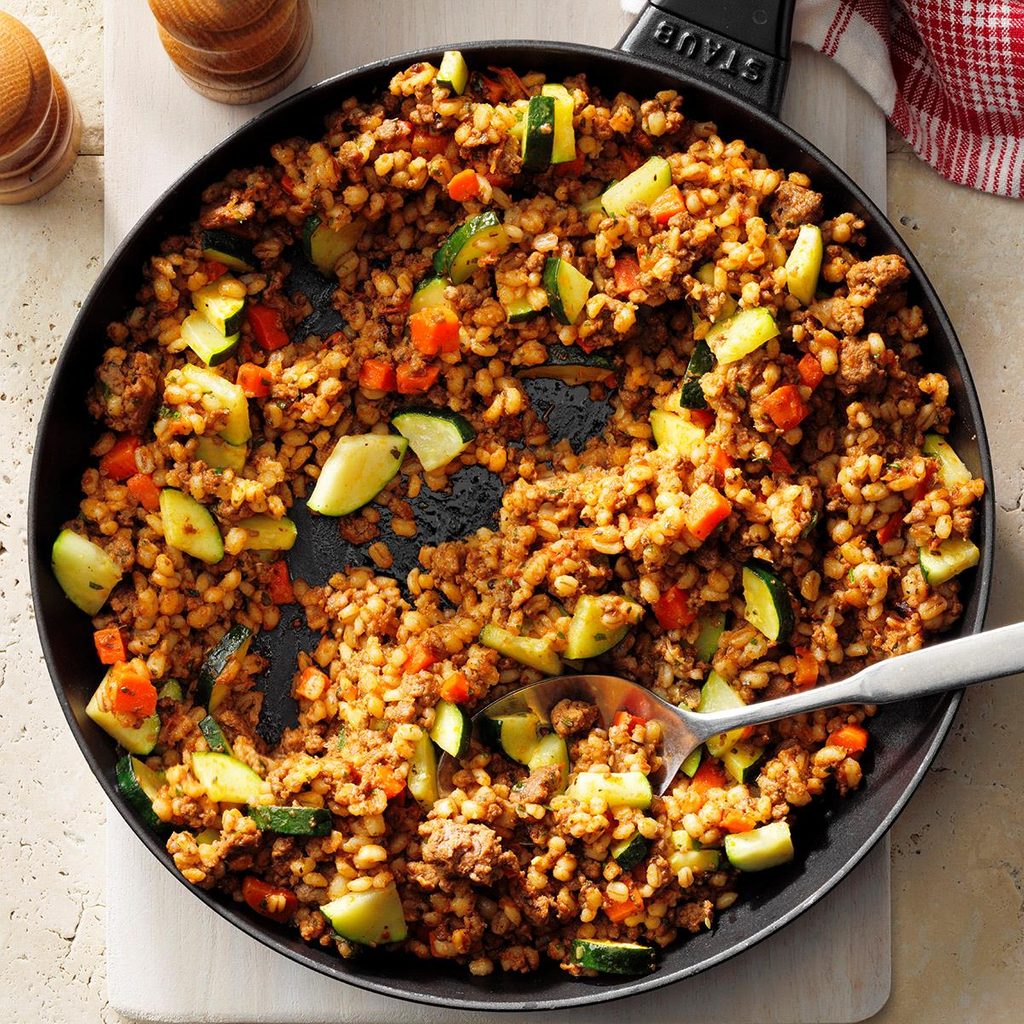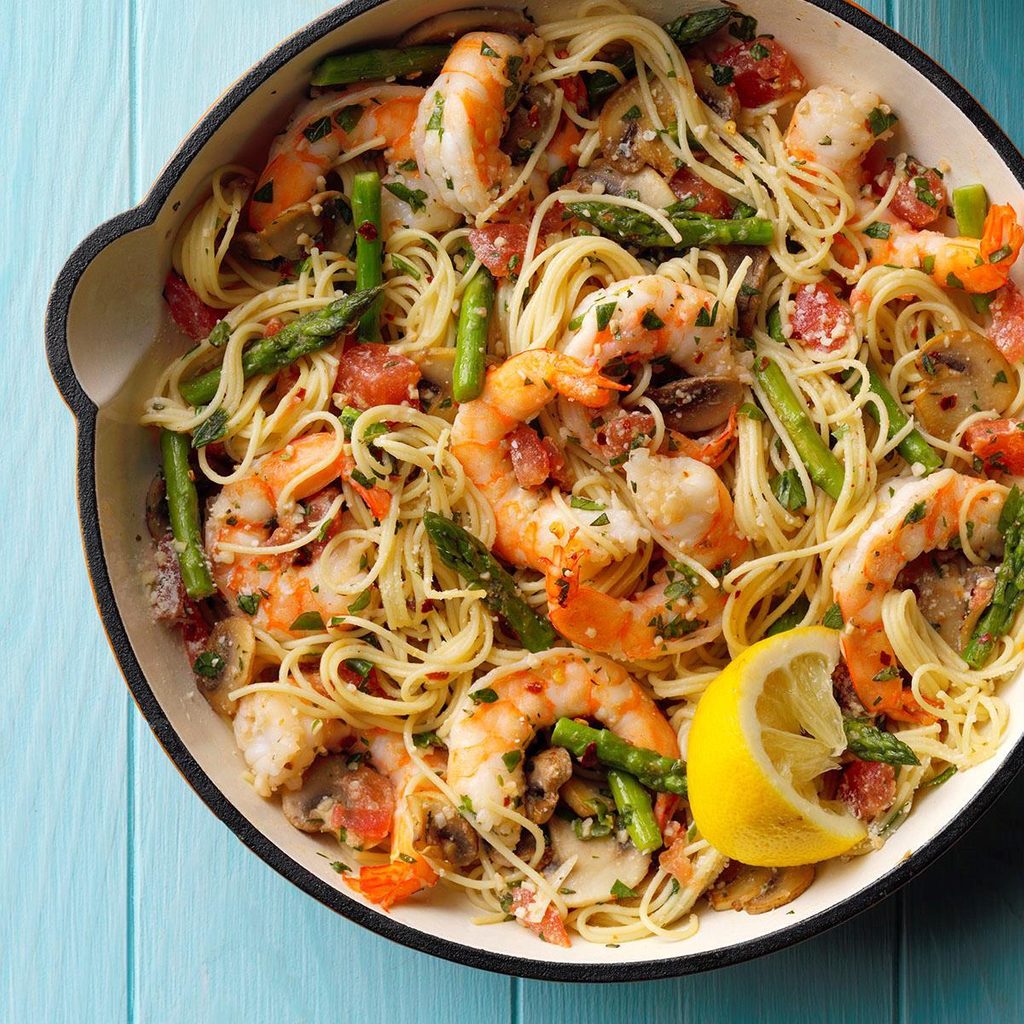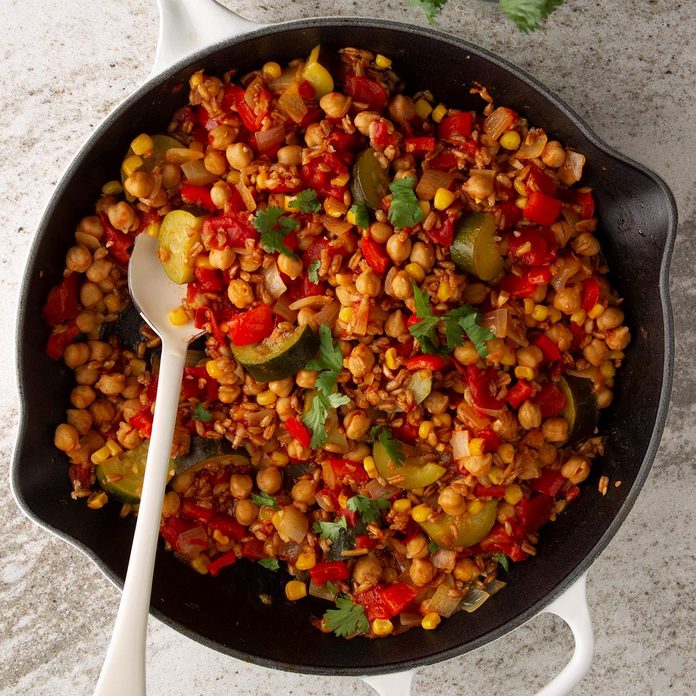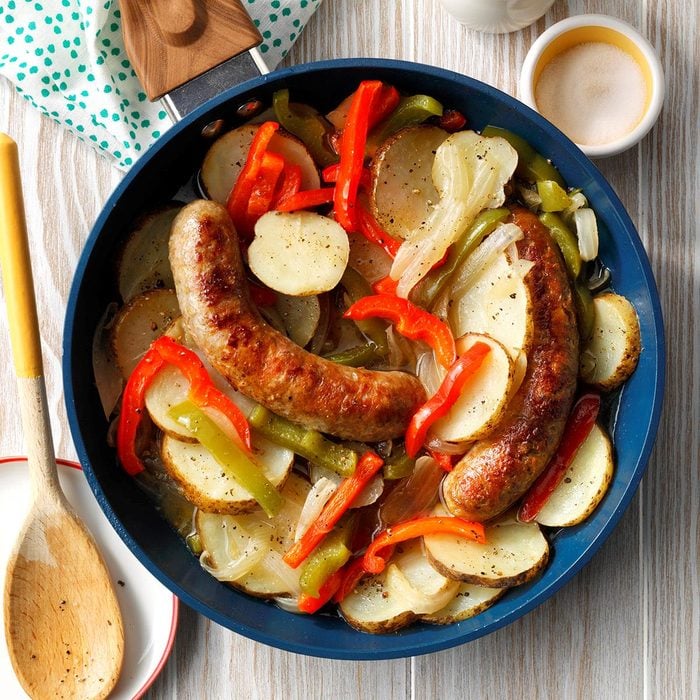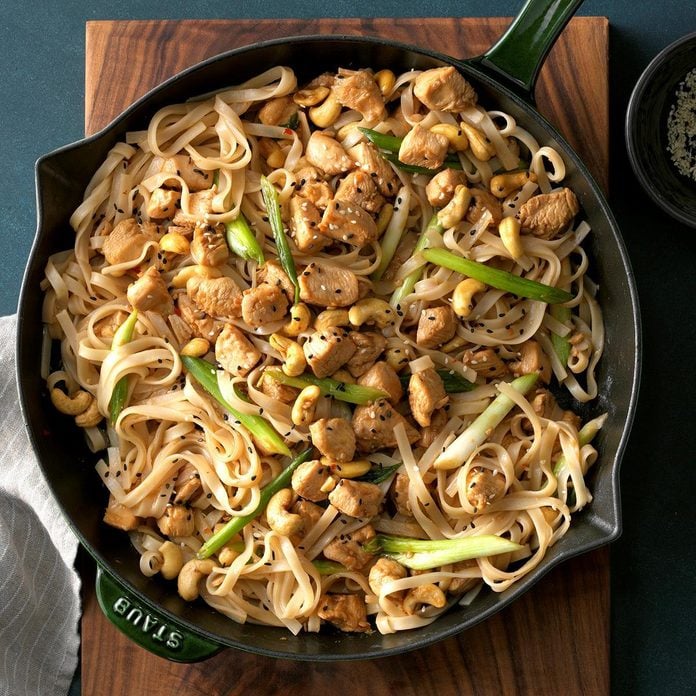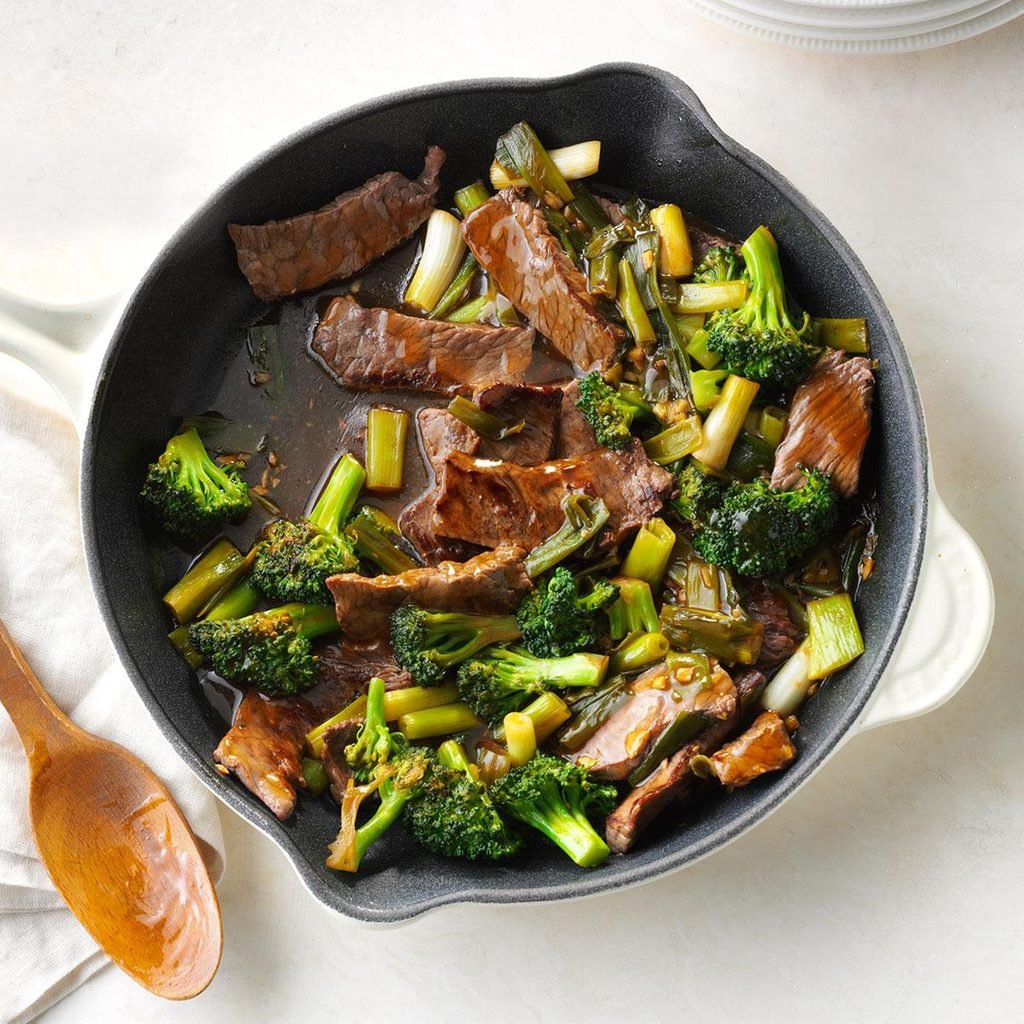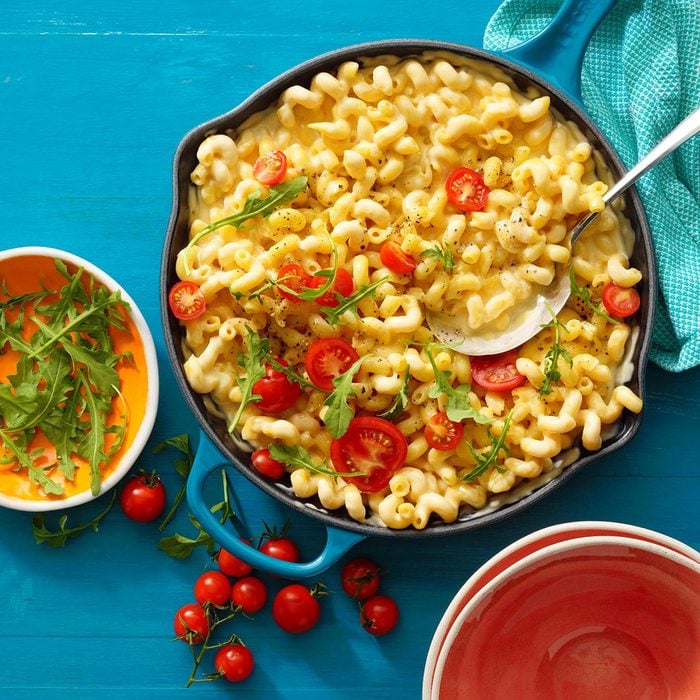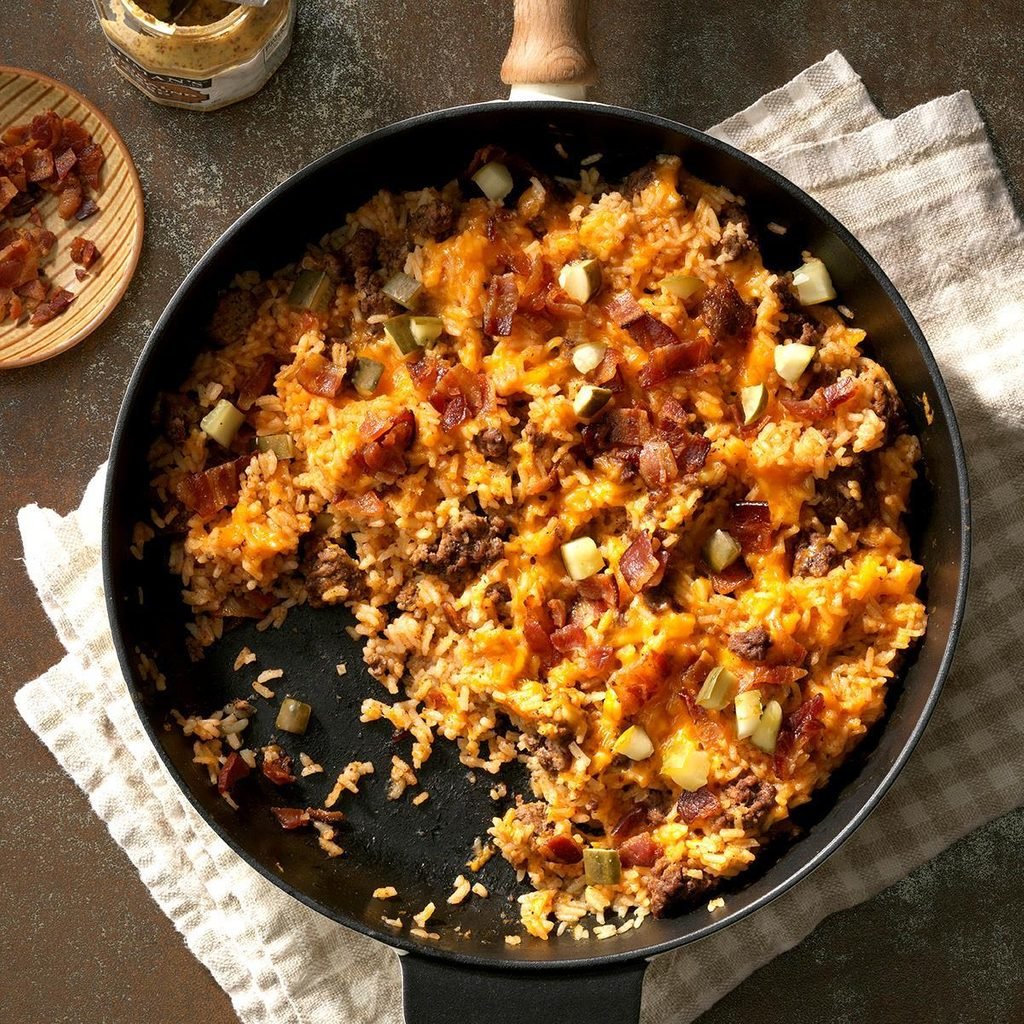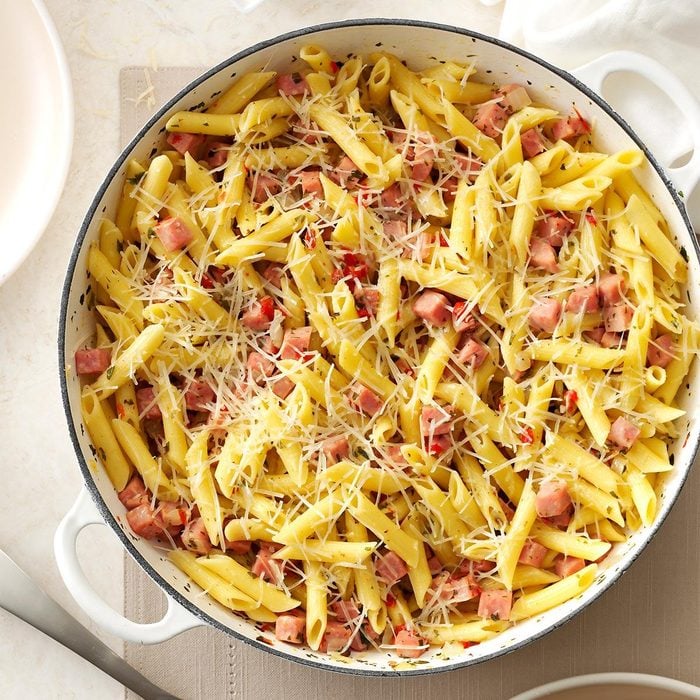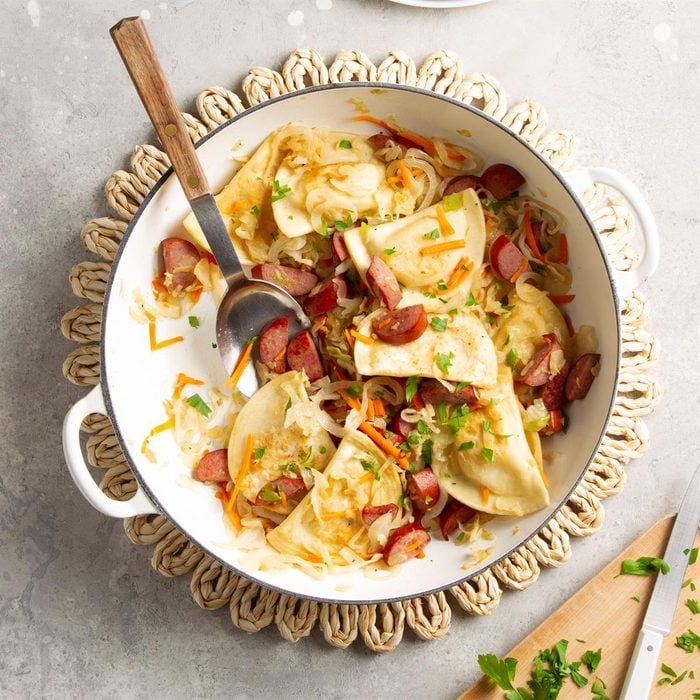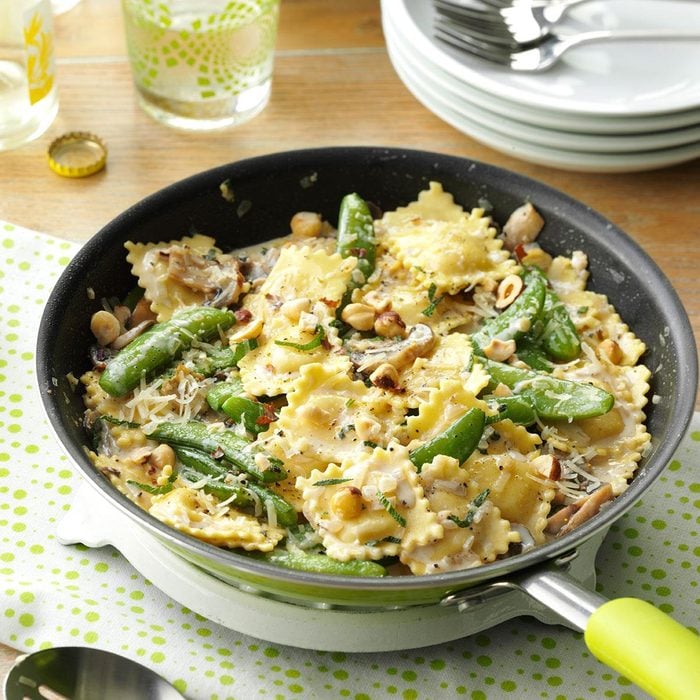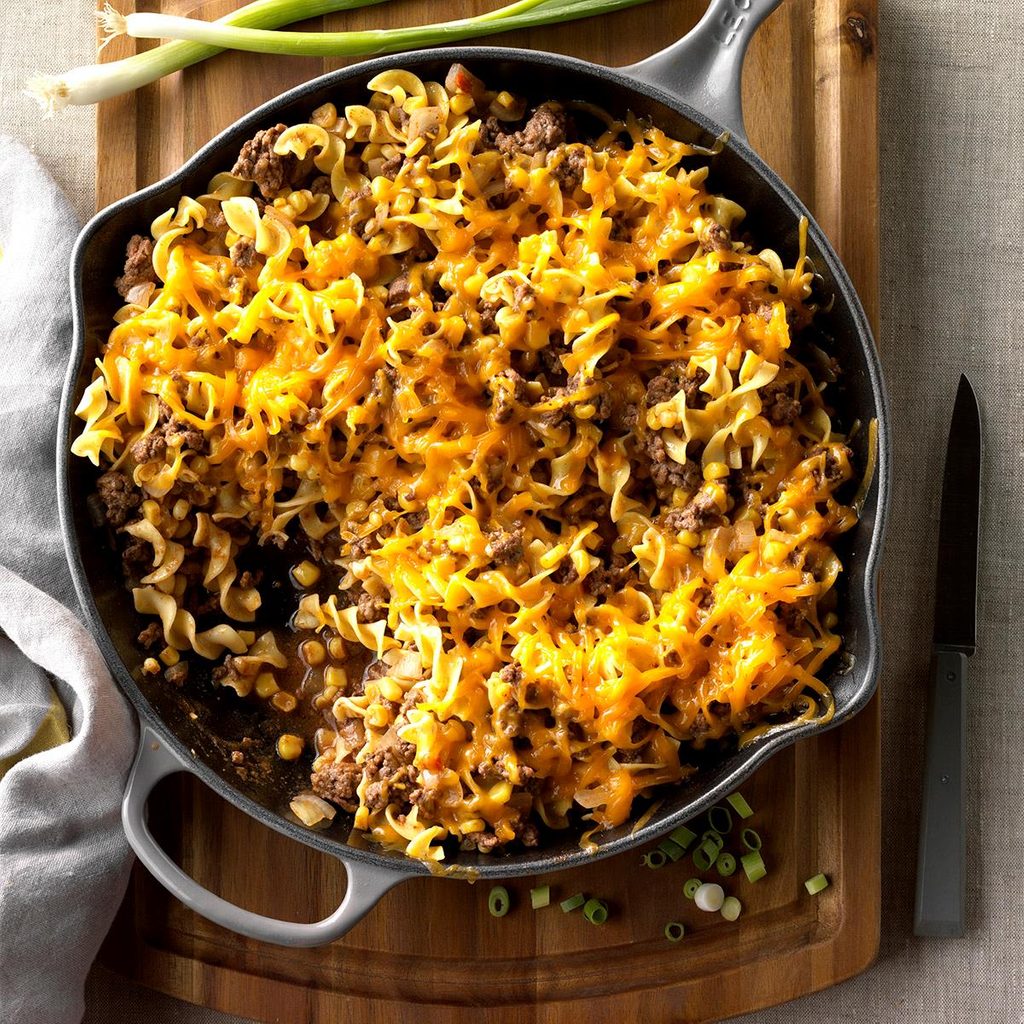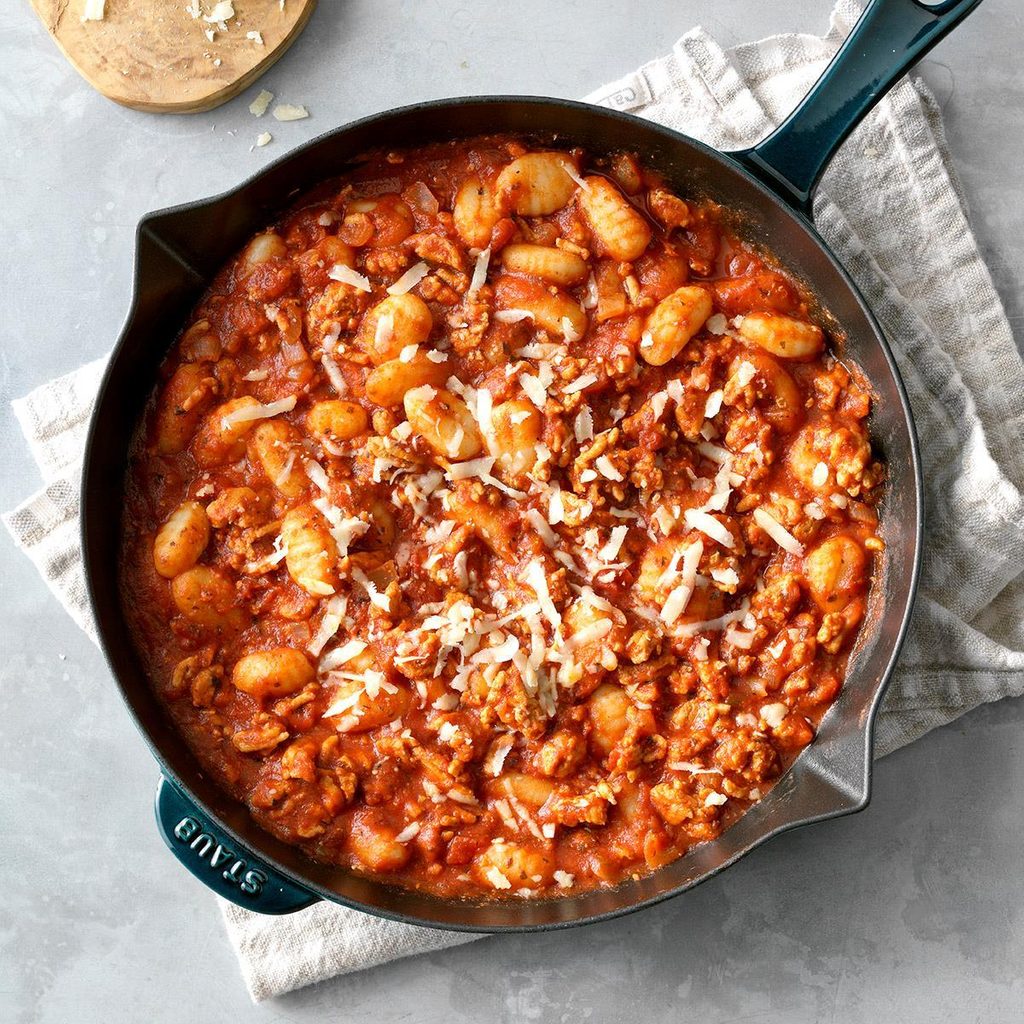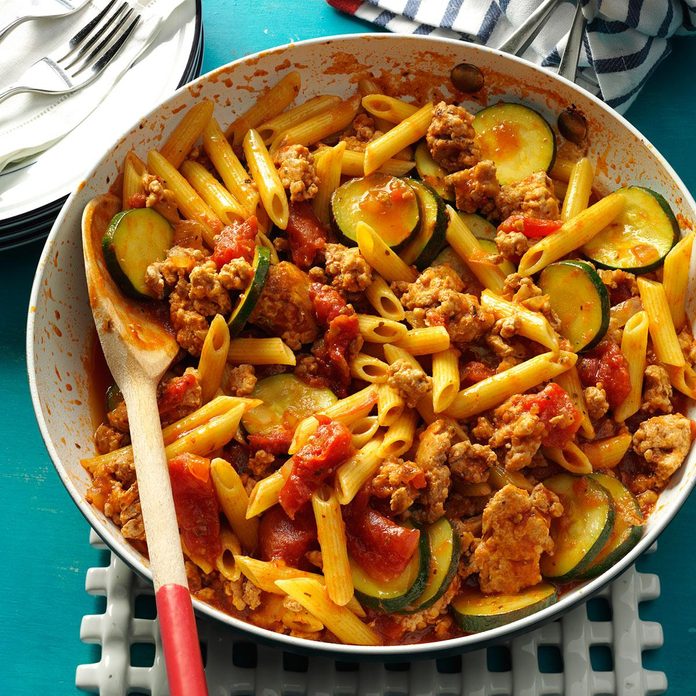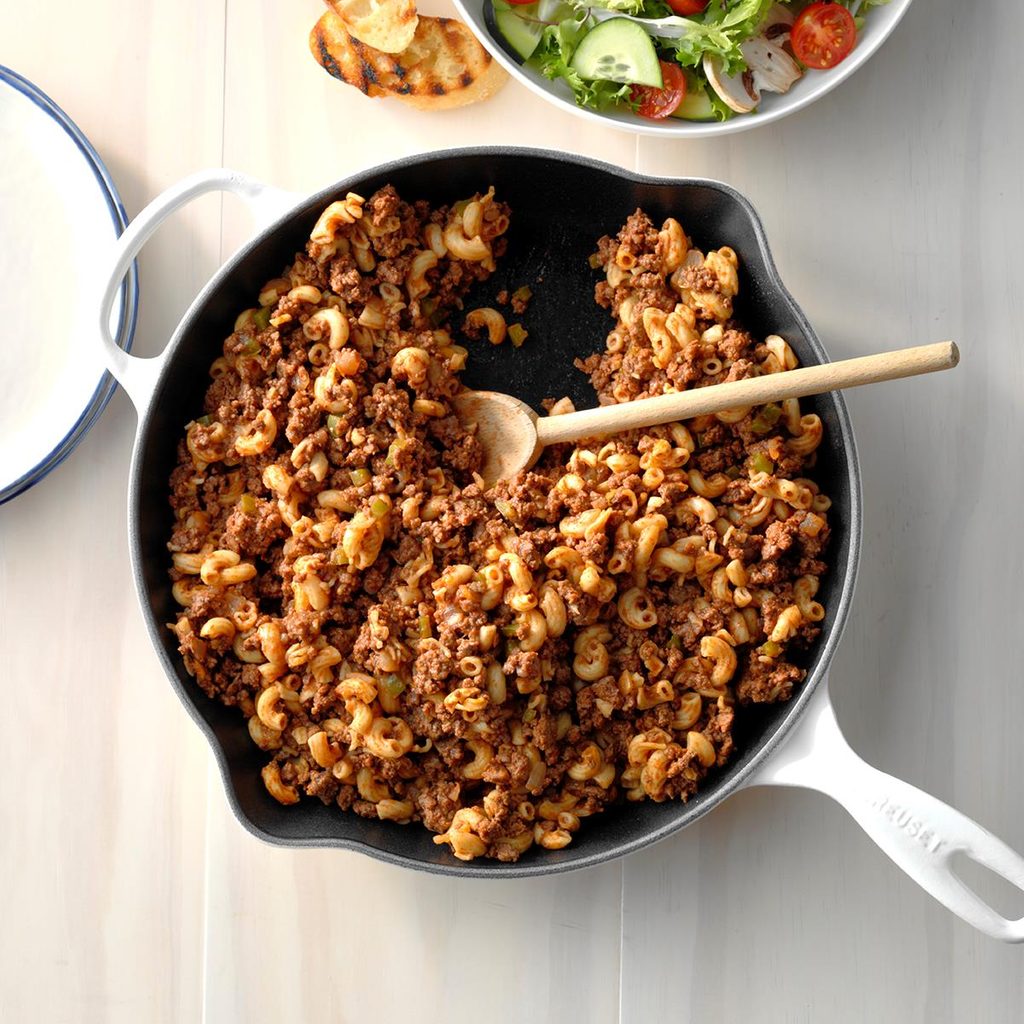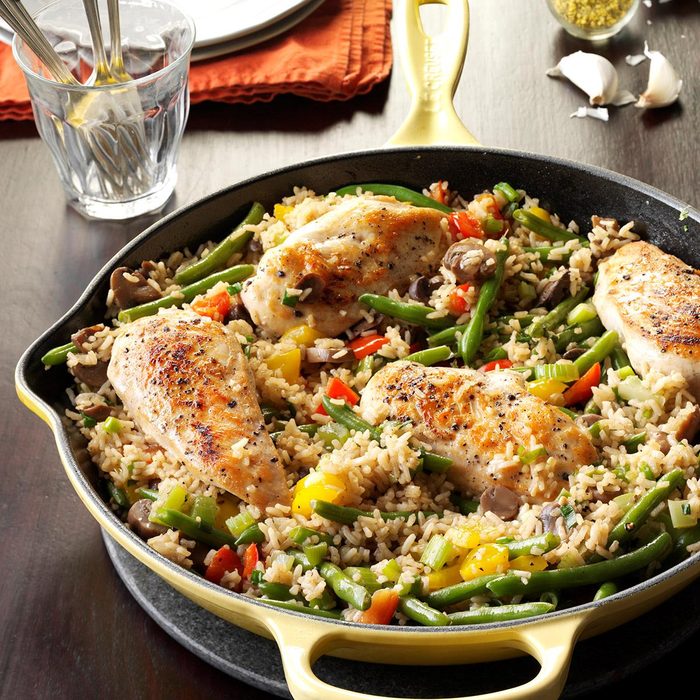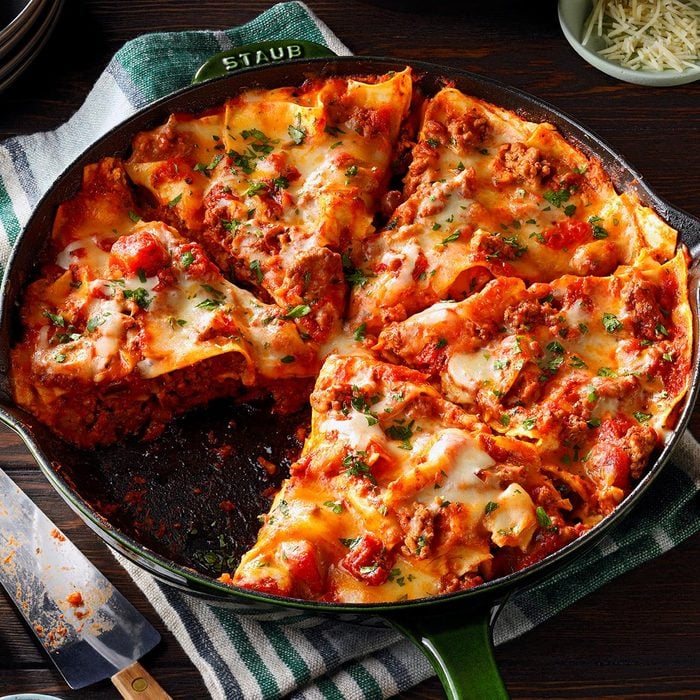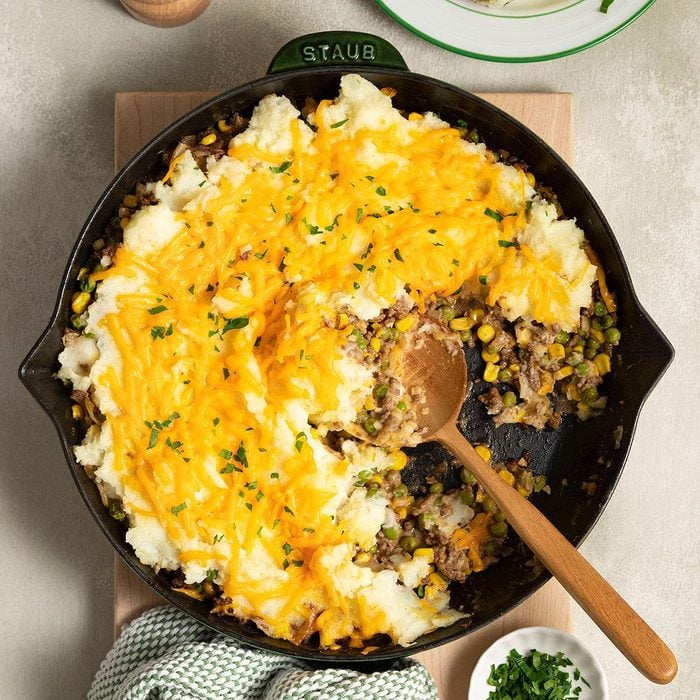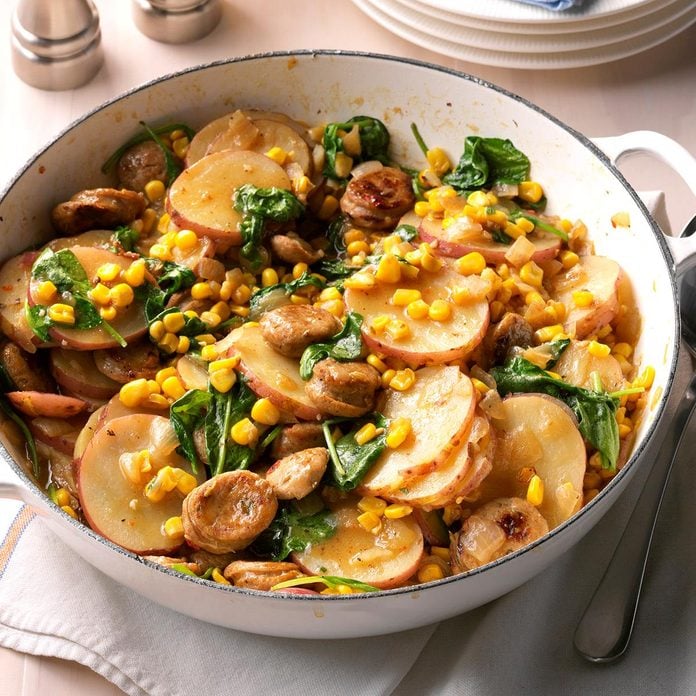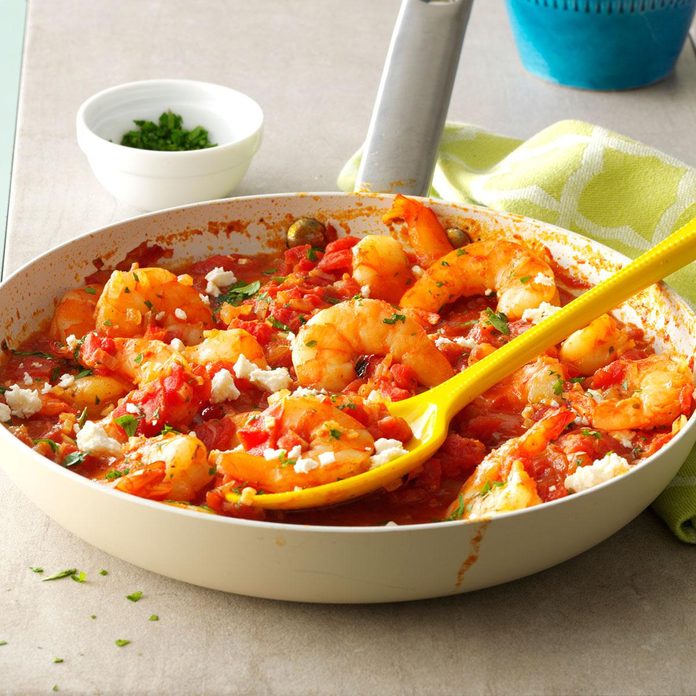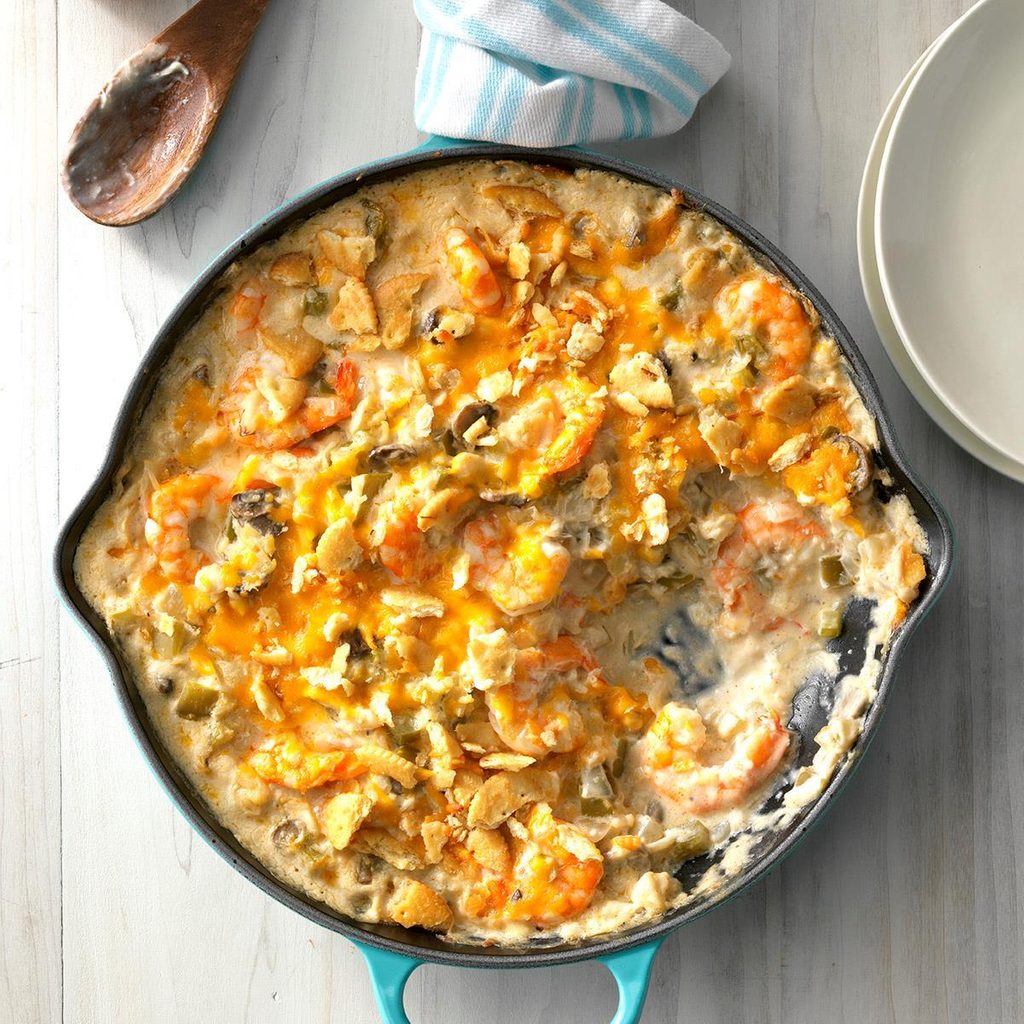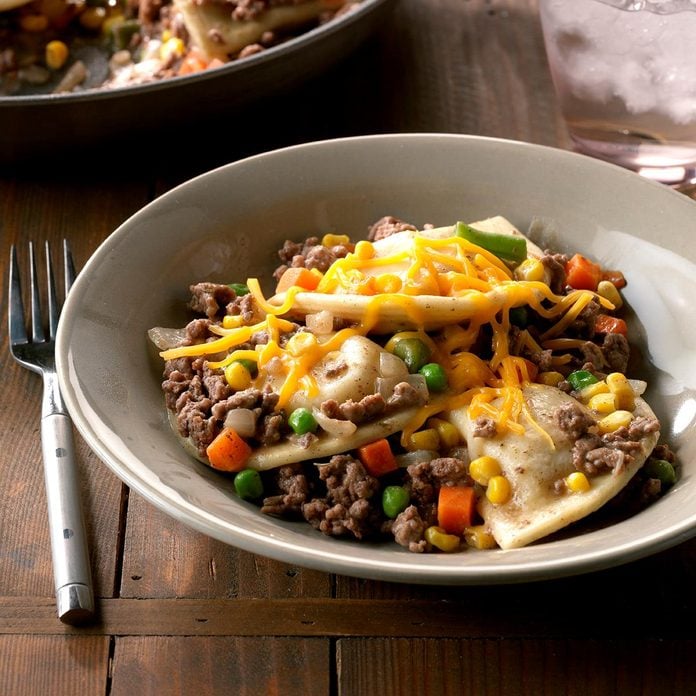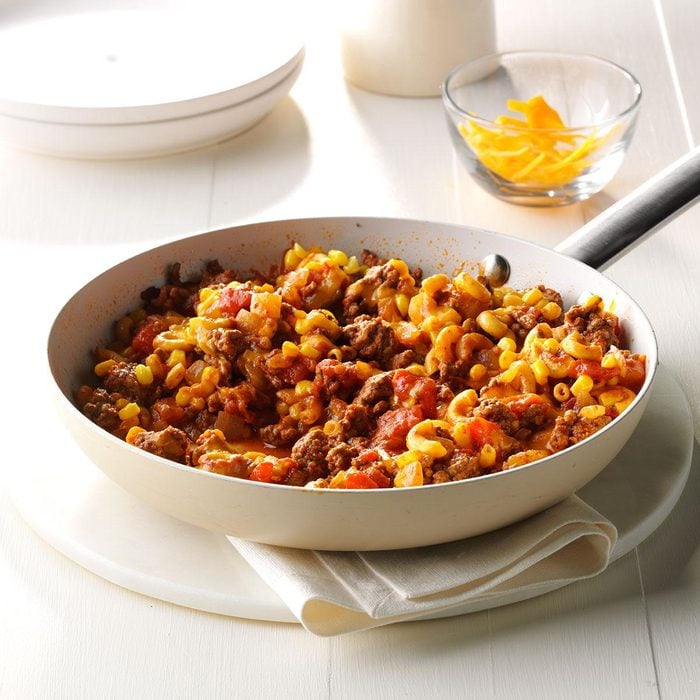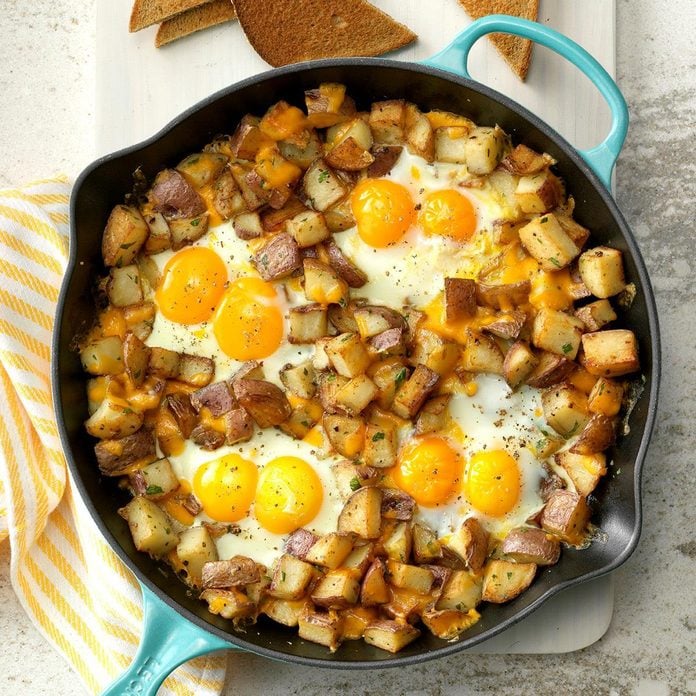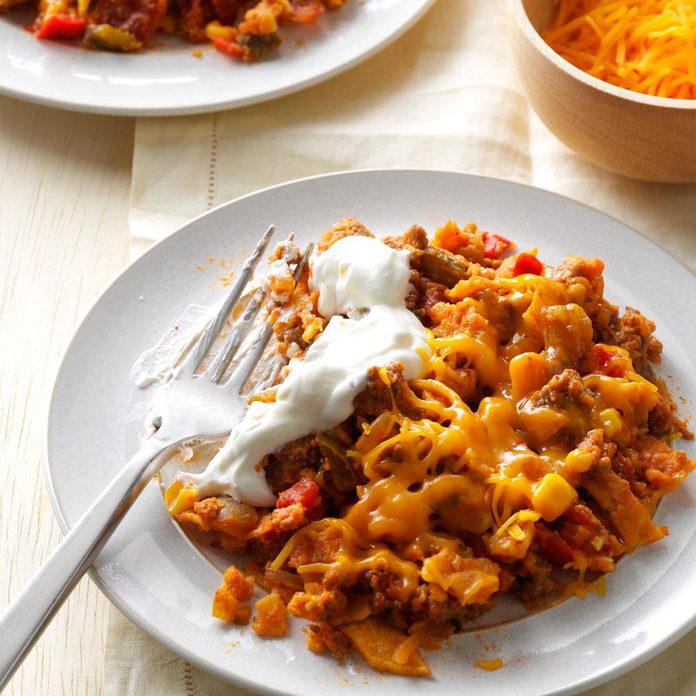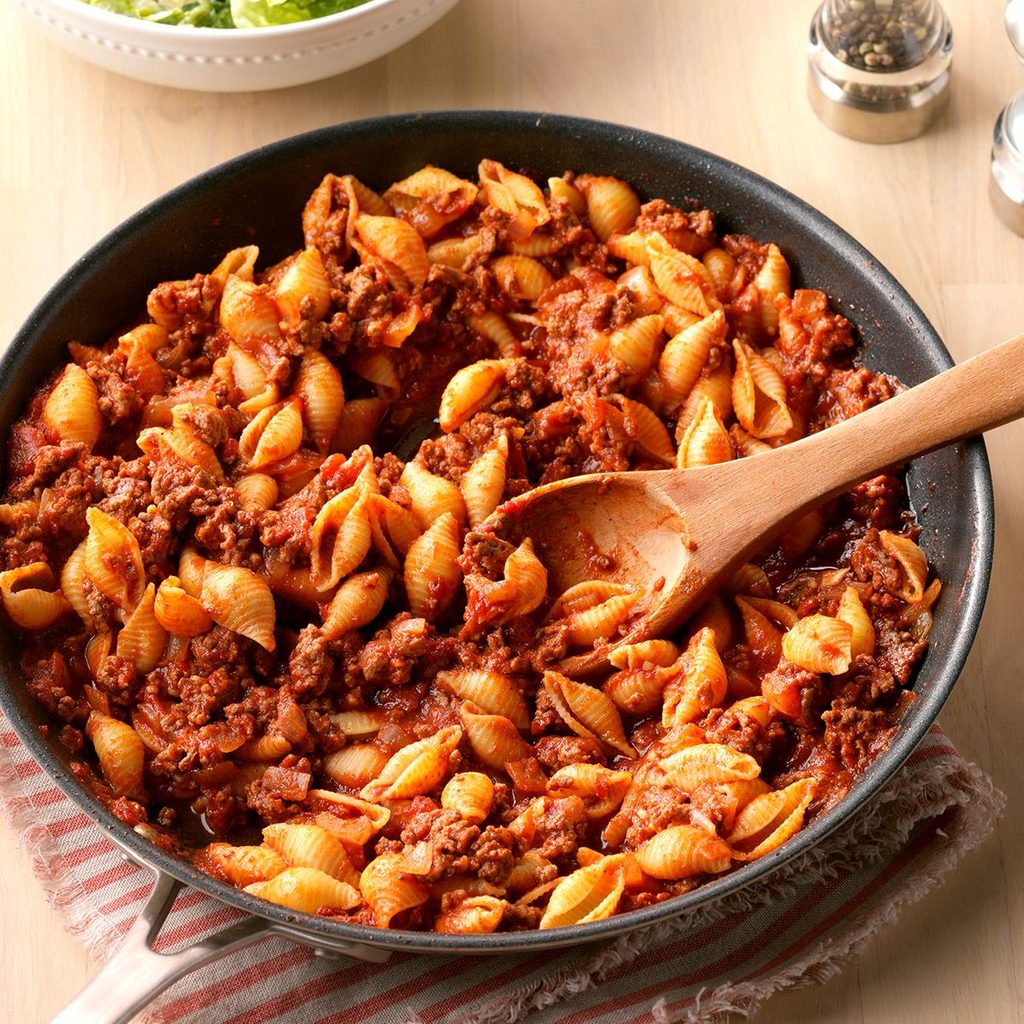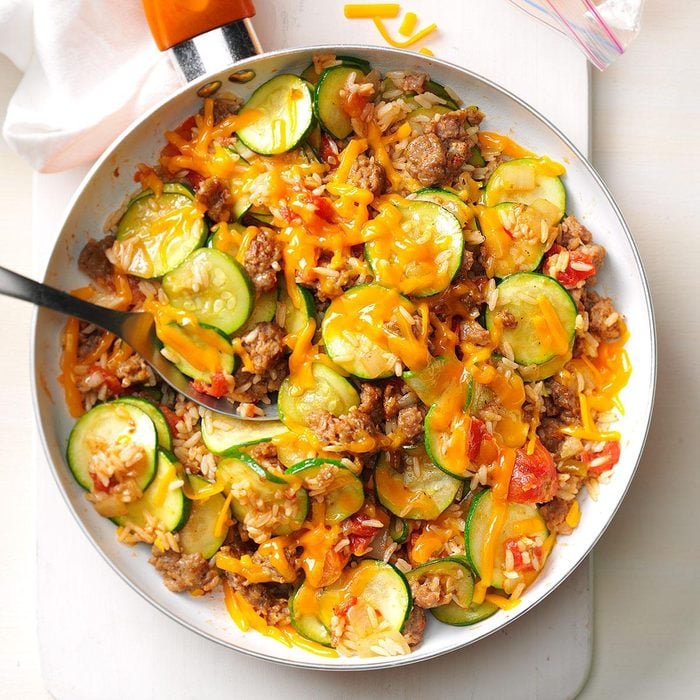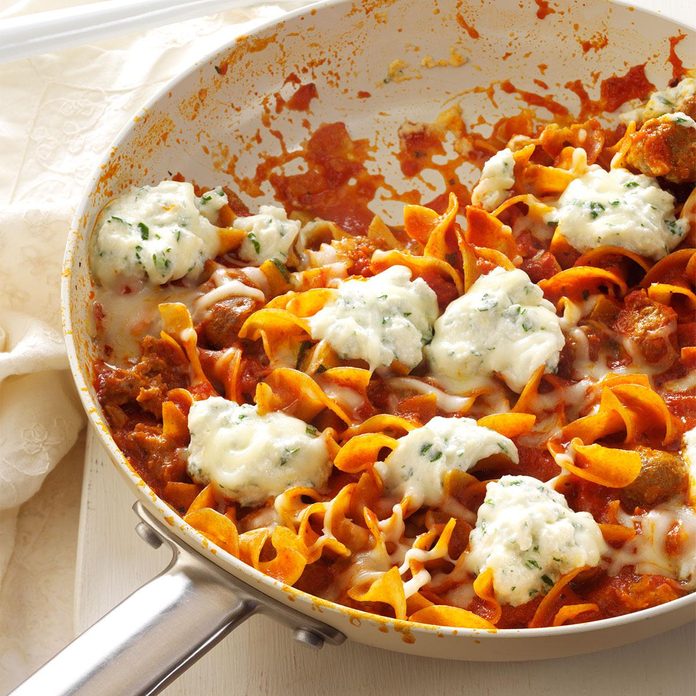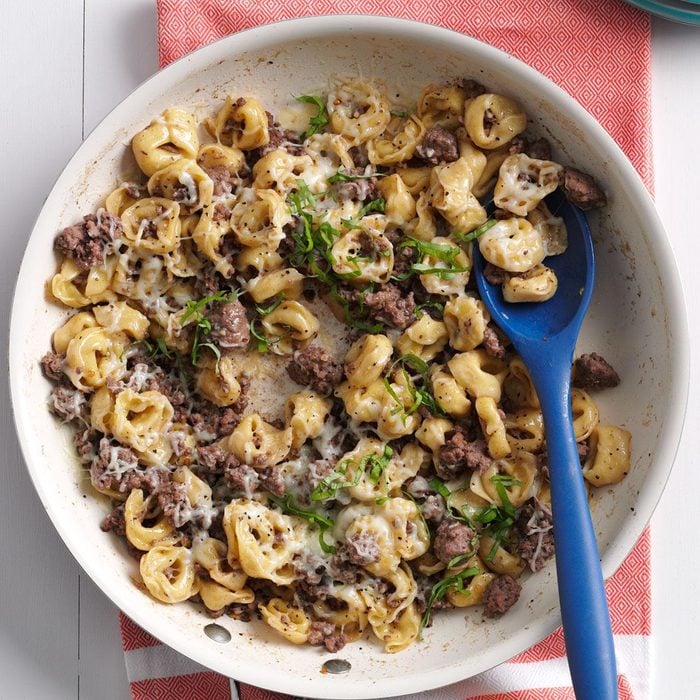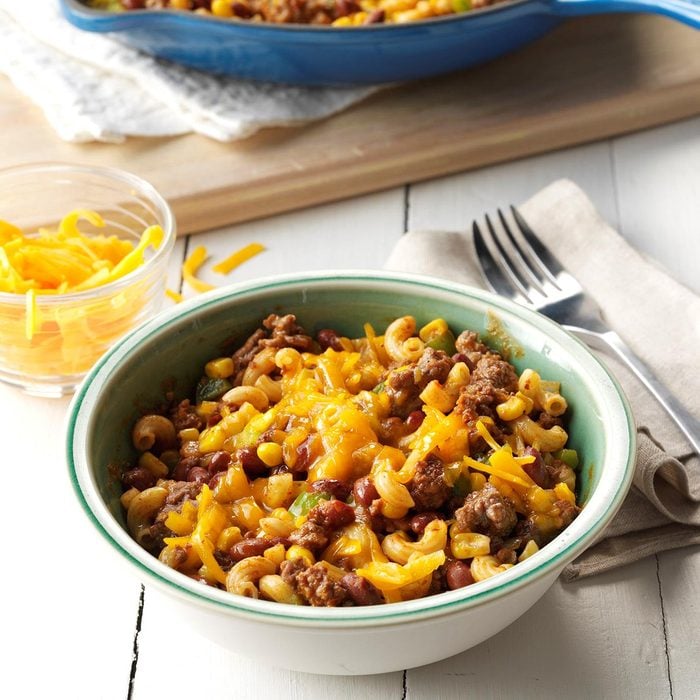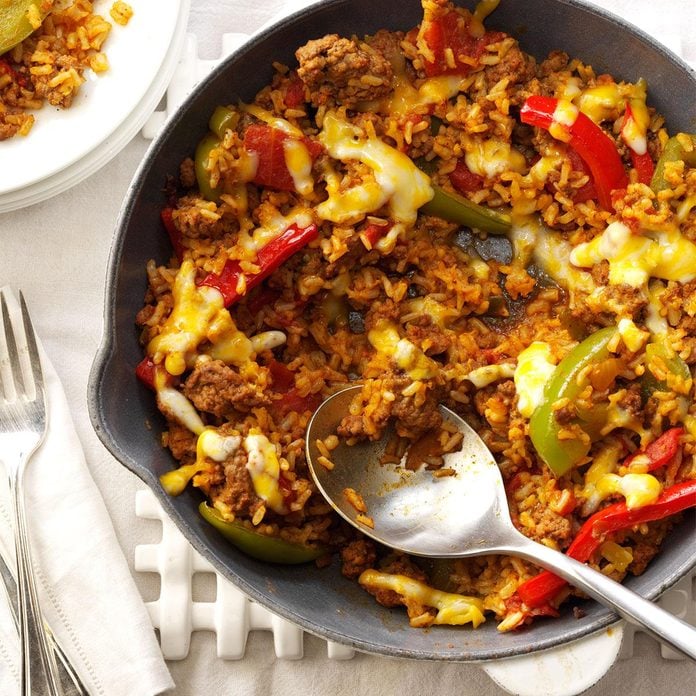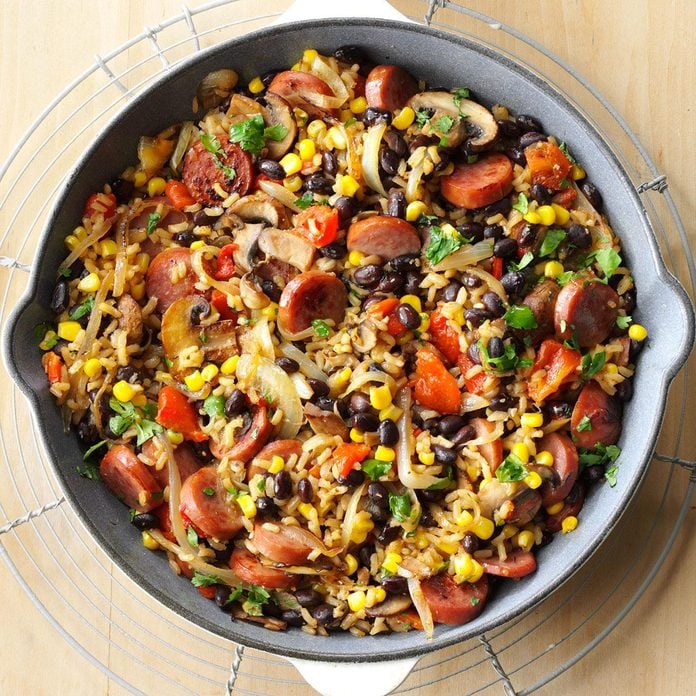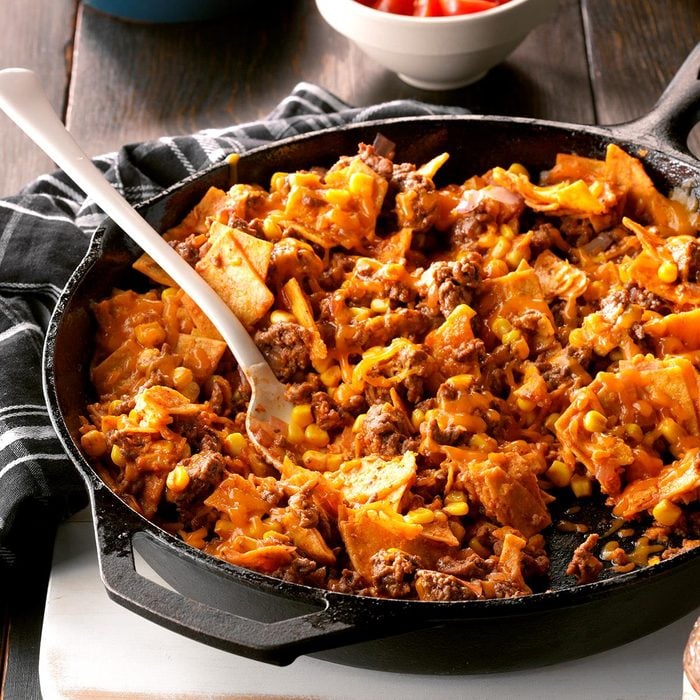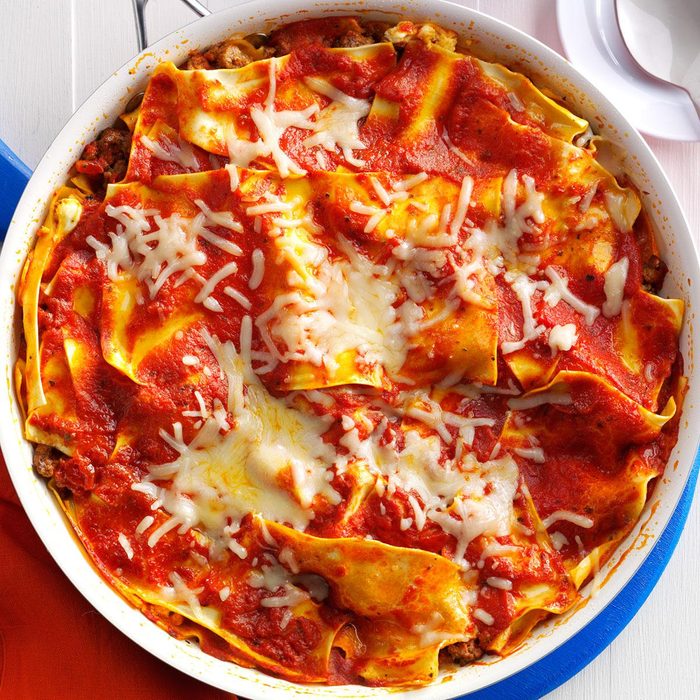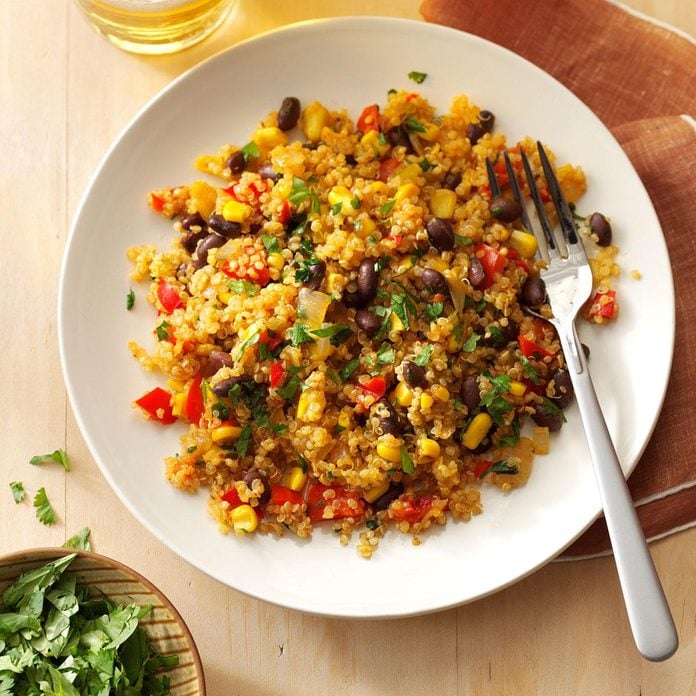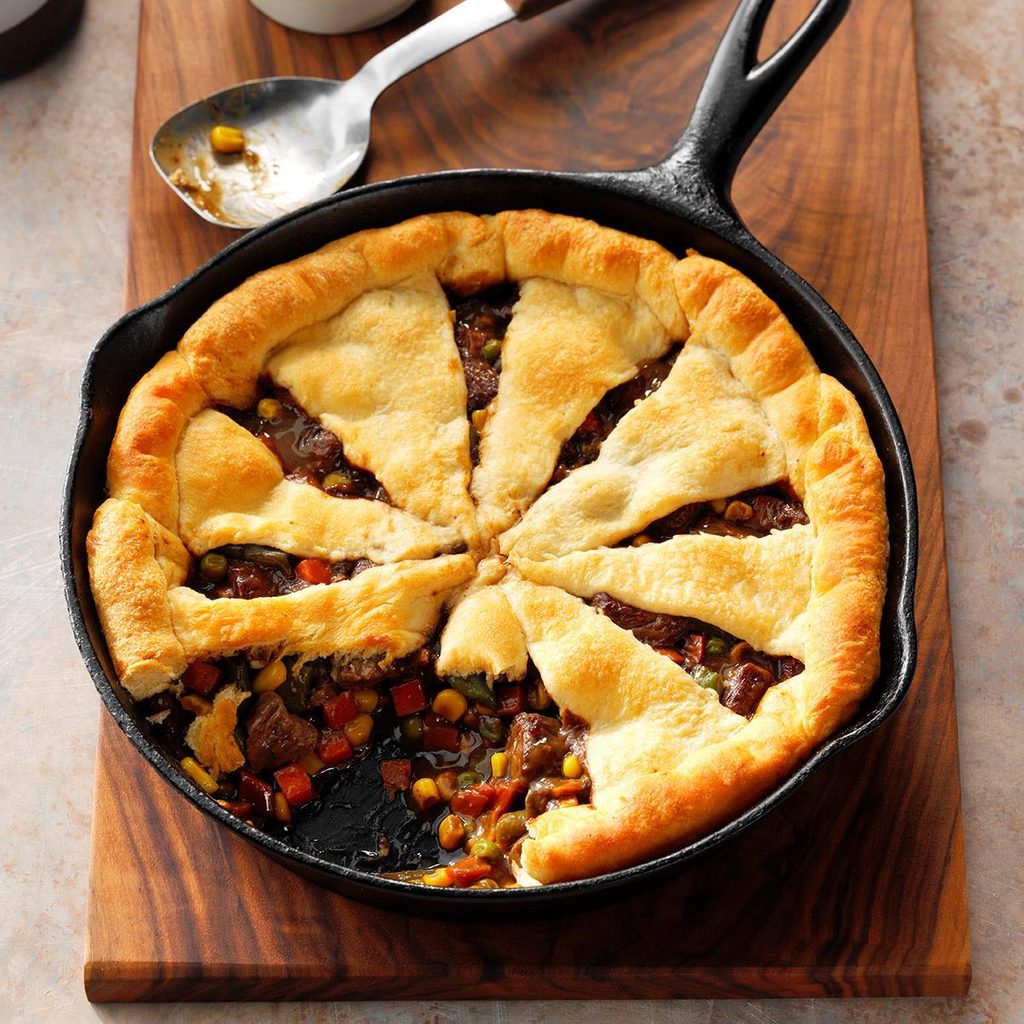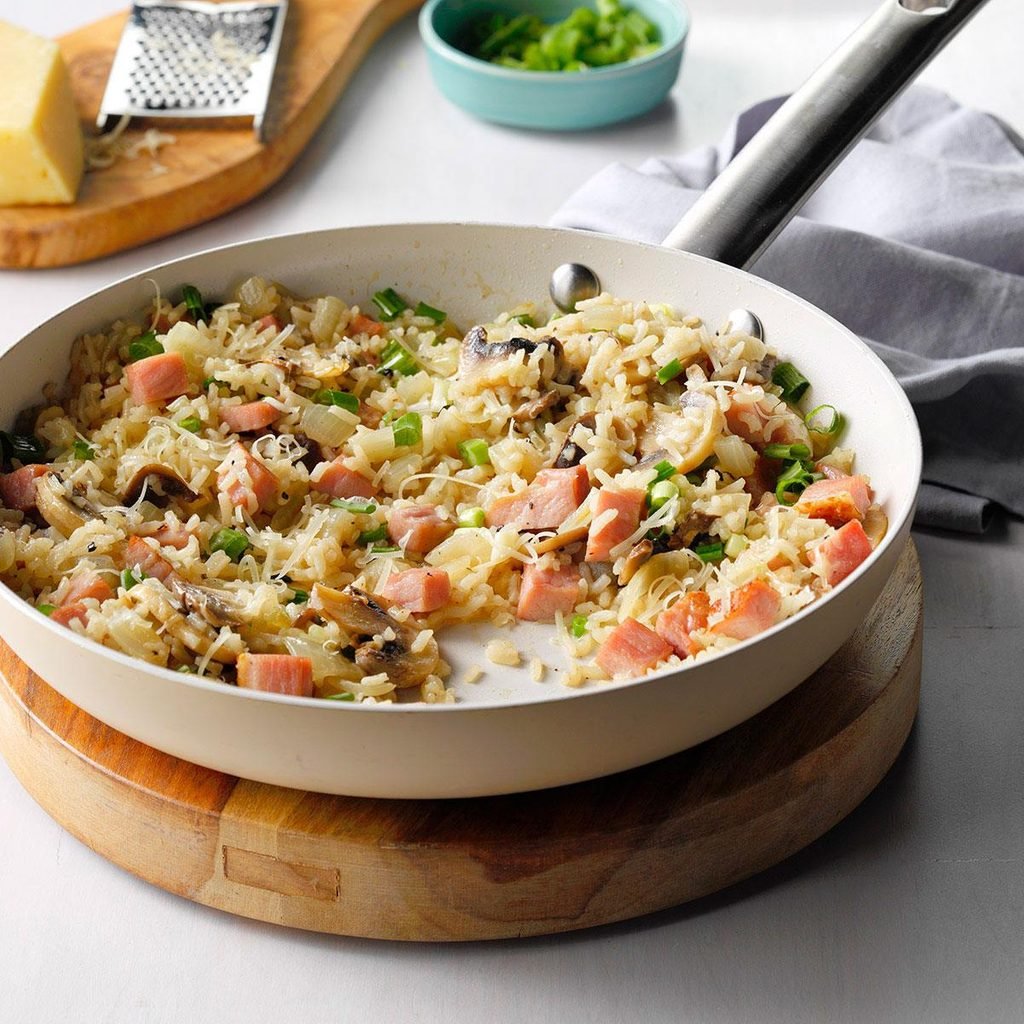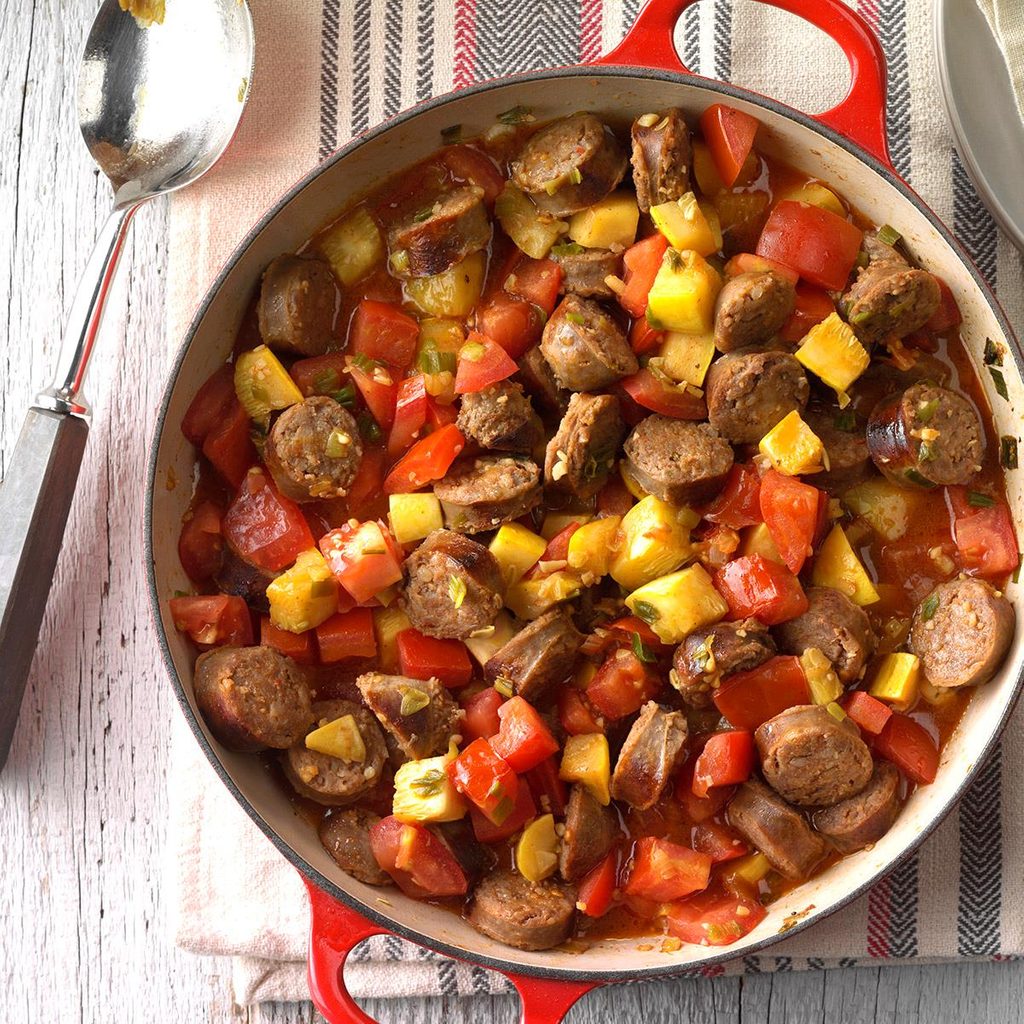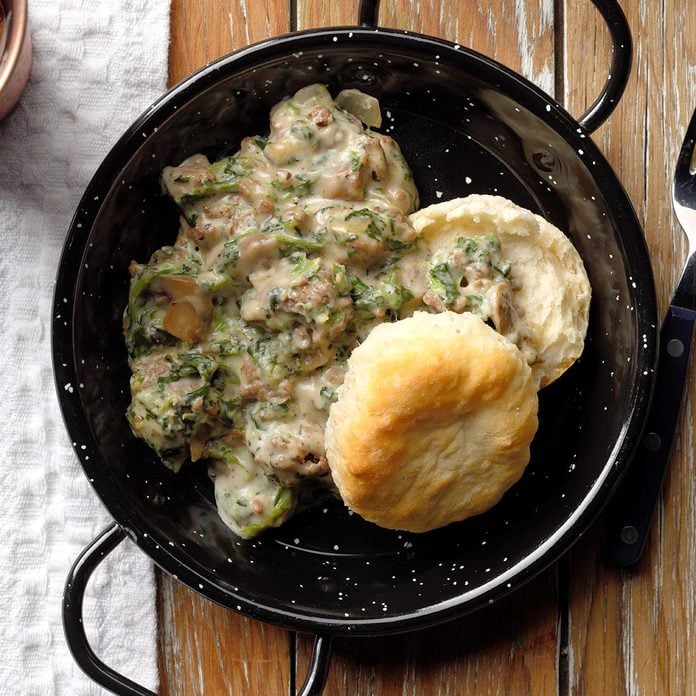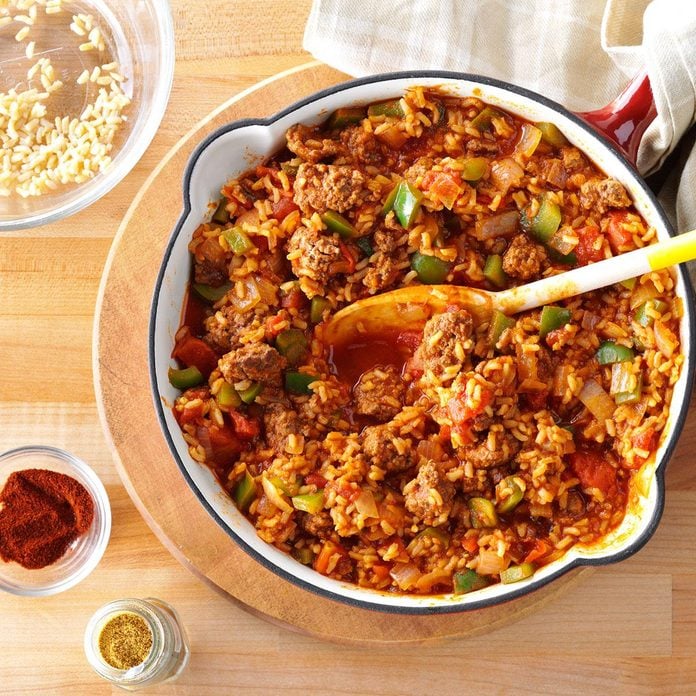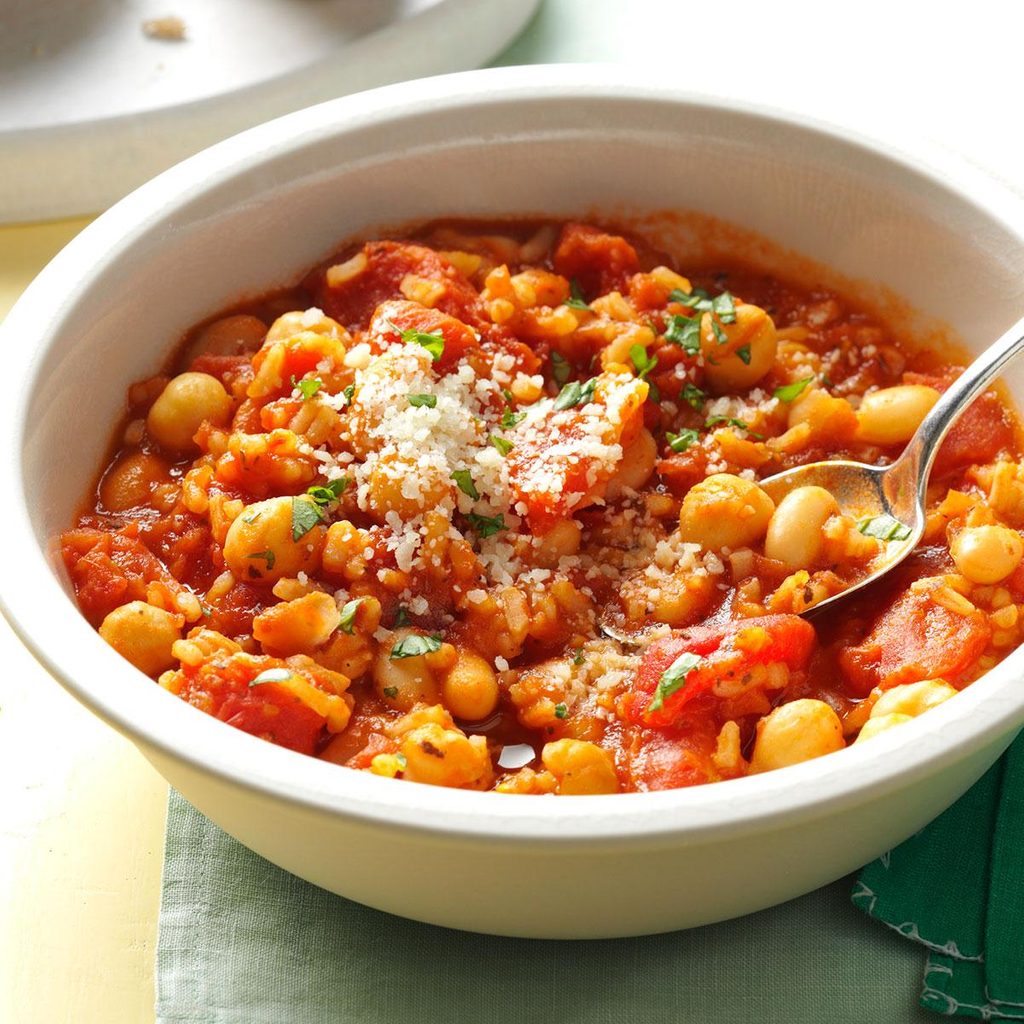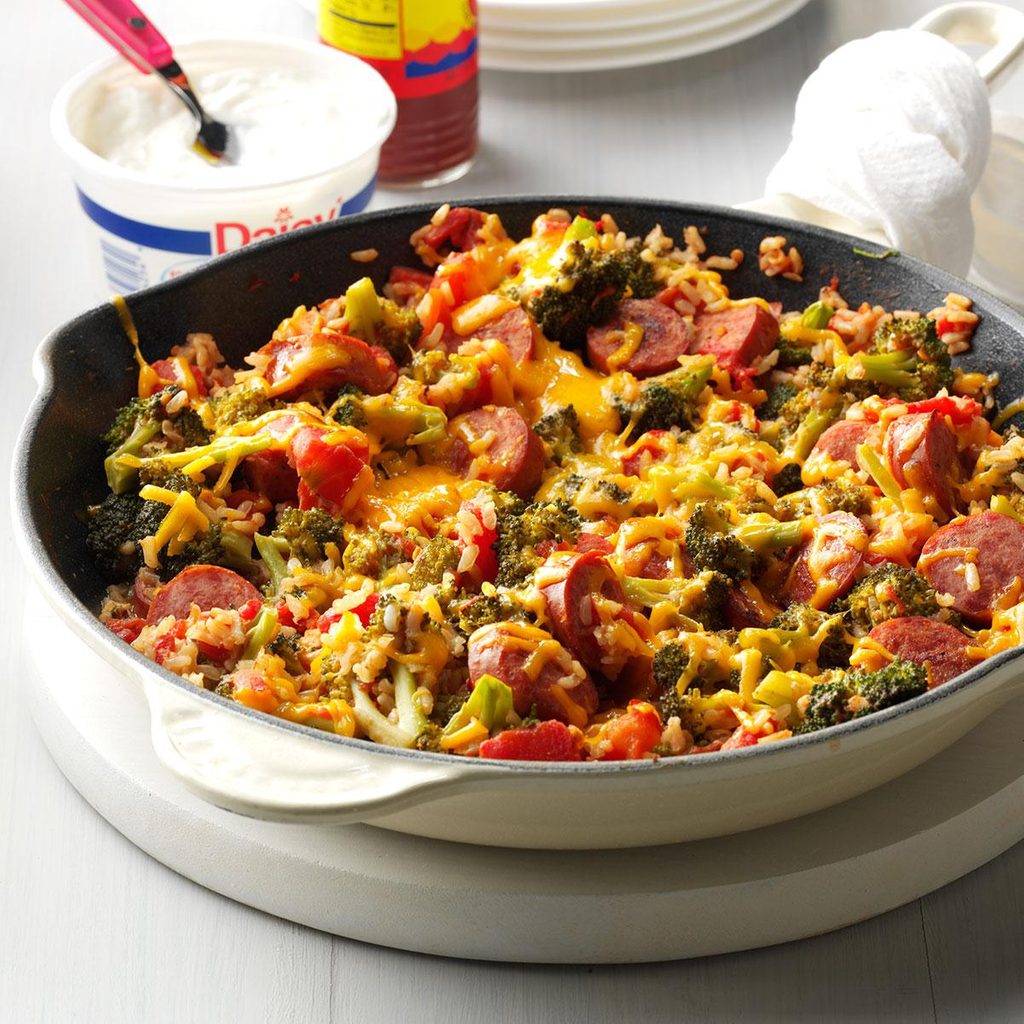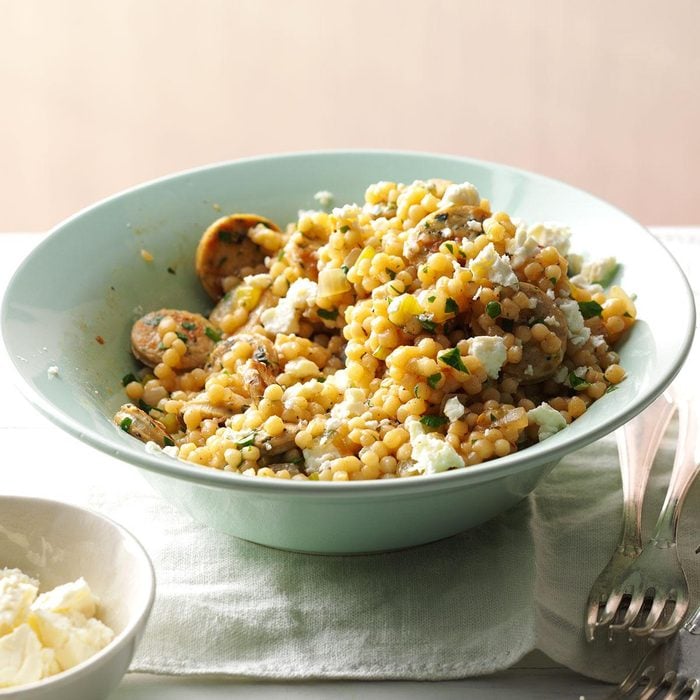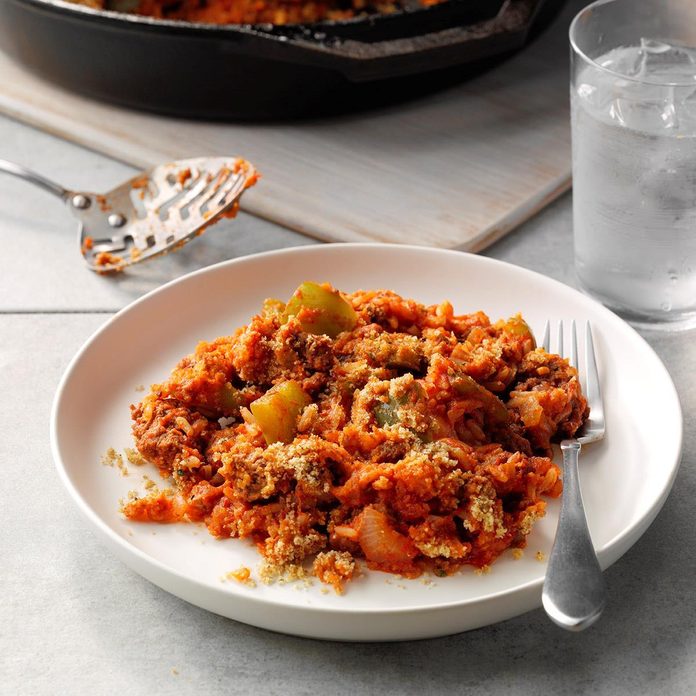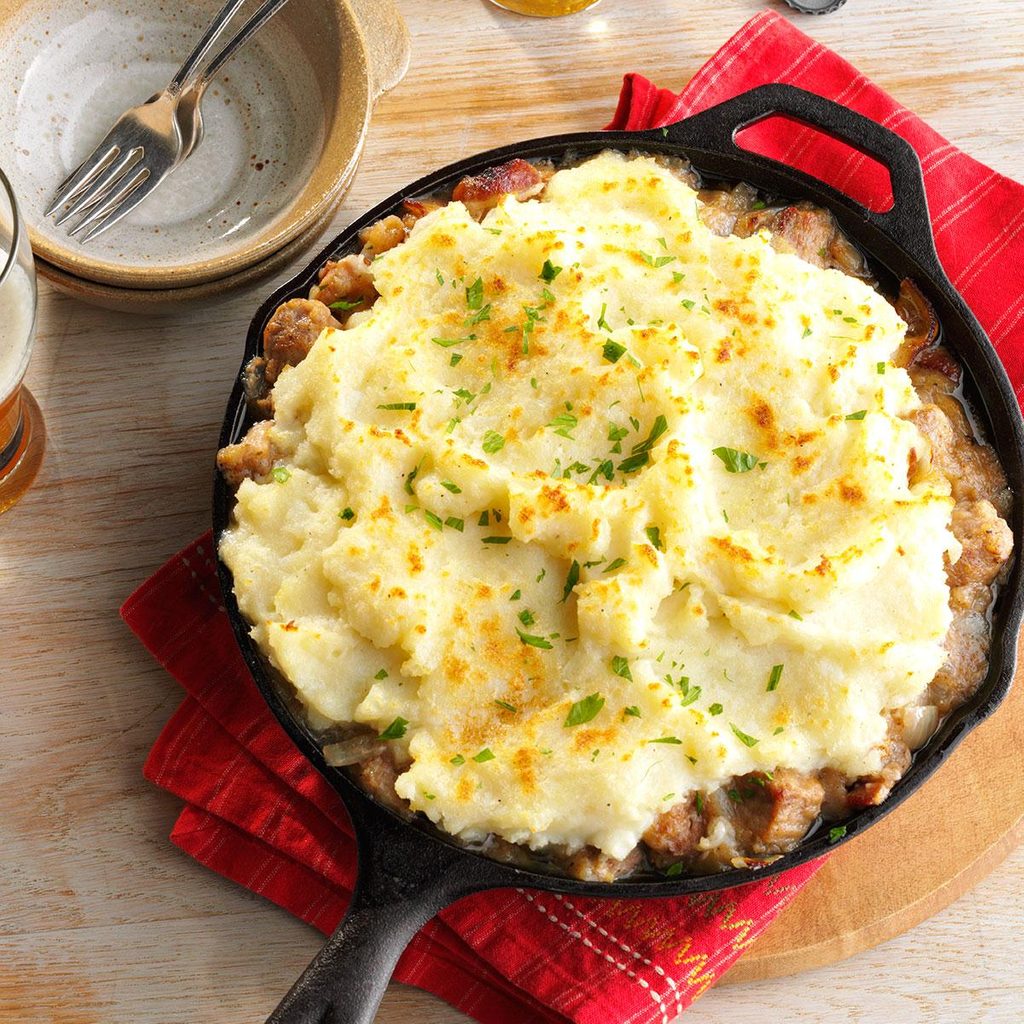Easy Chicken CreoleWhile I was growing up, my family spent time in Haiti, where we enjoyed eating many authentic dishes just like this easy chicken Creole recipe. It's now a meal my husband requests often. —Maxine Weaver, Petersburg, West Virginia
Beef with Ramen NoodlesI made up this recipe when I was looking for good Chinese food in beautiful Oregon. Each time I make this, I change something slightly. Leftovers heat easily in the microwave or fry pan.
One-Pot Creamy Vegan PastaHere’s a creamy vegan pasta recipe with tons of fresh sauteed vegetables. The spicy tomato sauce with sweet sun-dried tomatoes is the highlight of this dish. It’s the perfect meal for when you just don’t feel like cooking. —Michelle Miller,
Sunkissed Kitchen
Easy Italian Sausage and PeppersMy sister was hosting a birthday party and asked me to bring Italian sausage and peppers. I'd never made them before, so I altered a braised pepper recipe. Now family members request this dish often.—Jeanne Corsi, Arnold, Pennsylvania
Italian Turkey SkilletIt's a challenge to find imaginative ways to use leftovers. Here's a favorite of mine that you can easily make ahead for another dinner option. Prepare the recipe as directed, then transfer to a casserole dish and freeze up to three months. —Patricia Kile, Nokomis, Florida
Skillet TacosThis fast and healthy alternative to traditional tacos has a delicious southwestern flair. The fact that is comes together in just 30 minutes makes it even more irresistible. —Maria Gobel, Greenfield, Wisconsin
Barley Beef SkilletEven my 3-year-old loves this family-favorite beef barley skillet. It's very filling, inexpensive and packed with veggies. It's also really good spiced up with chili powder, cayenne or a dash of Tabasco. —Kit Tunstall, Boise, Idaho
Asparagus 'n' Shrimp with Angel HairWe’ve all heard that the way to a man’s heart is through his stomach, so when I plan a romantic dinner, this shrimp asparagus pasta with angel hair is one dish I like to serve. It is easy on the budget and turns out perfectly for two. —Shari Neff, Takoma Park, Maryland
Vegetarian Farro SkilletFarro is a type of wheat that was popular in ancient Rome. A good source of fiber, it includes more protein than most grains, making it a smart choice for meatless meals like this vegetarian farro skillet dish. —Taste of Home Test Kitchen, Milwaukee, Wisconsin
Sausage Potato SkilletGrowing up, I would eat this sausage and potato skillet recipe almost every day. I could never get enough of my favorite meal! —Amelia Bordas, Springfield, Virginia
Cashew Chicken with NoodlesI tried this recipe for chicken with cashew nuts when making freezer meals with some friends. I was smitten! It's quick, easy and so delicious! —Anita Beachy, Bealeton, Virginia
Saucy Beef with BroccoliWhen I’m looking for a fast entree, I turn to this beef and broccoli stir-fry. It features a tantalizing sauce made with garlic and ginger. —Rosa Evans, Odessa, Missouri
Skillet Mac & CheeseThis creamy mac ’n’ cheese is so simple it’s almost too easy! —Ann Bowers, Rockport, Texas
Barbecue Pork and Penne SkilletI'm the proud mother of wonderful and active children. Simple, delicious and quick meals like this BBQ pork skillet are perfect for us to enjoy together after school activities, especially if I have leftover pulled pork. —Judy Armstrong, Prairieville, Louisiana
Bacon Cheeseburger RiceMy husband and I thought the original skillet dish lacked pizzazz, so we created this tastier version. I've had teenage nieces and nephews request the recipe after their first bite. —Joyce Whipps, West Des Moines, Iowa
Pretty Penne Ham SkilletI'm a busy nurse, so fast meals are a must. This pasta is a tasty change of pace from potato-ham casseroles. —Kathy Stephan, West Seneca, New York
Sausage Pierogi SkilletI made this simple pierogies and sausage recipe one night when I hadn’t planned anything for dinner. It’s convenient because it uses items I usually have on hand. Plus, there’s hardly any cleanup! —Susan Held, Cooksville, Maryland
Ravioli with Snap Peas & MushroomsTopped with the toasty texture and flavor of hazelnuts, this pasta makes an easy, earthy weeknight dinner. I serve it with an herb and lettuce salad and white wine. —Charlene Chambers, Ormond Beach, Florida
Beef Skillet SupperSometimes I'll make extra of this comforting, noodle-y supper to guarantee leftovers. It's a great take-along dish for work or school. Trim calories from the entree by substituting ground turkey for the beef and low-fat cheese for the full-fat cheddar. —Tabitha Allen, Cypress, Texas
Gnocchi Chicken SkilletStovetop chicken and gnocchi recipes like this one make for a homey dinner in a hurry. Personalize it with your own favorite sauce and seasonings. —Taste of Home Test Kitchen
Jiffy Ground Pork SkilletSome people call it dinner hour, but many of us call it rush hour. Slow down the pace with this so-simple mouthwatering ground pork meal. The only thing you'll have left over is time to share with your family at the table. —Brigitte Schaller, Flemington, Missouri
Skillet Beef and MacaroniI found this simple skillet recipe many years ago on a can label. I made some tweaks, and my family loved it. Because it's so easy to put together, it's a real timesaver for people with super busy schedules. —Maxine Neuhauser, Arcadia, California
Chicken Rice SkilletPleasant seasonings and plenty of vegetables highlight this traditional chicken and rice pairing. Leftovers are great reheated in the microwave. —Jan Balata, Kilkenny, Minnesota
One-Skillet LasagnaThis is hands-down one of the best skillet lasagna recipes our testing panel has ever tasted. And with classic flavors and cheesy layers, it’s definitely kid-friendly. —Taste of Home Test Kitchen
Skillet Shepherd's PieThis is the best shepherd's pie recipe I've ever tasted. It's very quick to make, and I usually have most—if not all—of the ingredients already on hand. —Tirzah Sandt, San Diego, California
Sausage & Vegetable Skillet DinnerI threw this sausage recipe together one night to use up produce before going out of town. Who knew it was going to be such a hit! Now it’s a recipe I turn to whenever time is tight. —Elizabeth Kelley, Chicago, Illinois
Feta Shrimp SkilletMy husband and I tried a dish similar to this on our honeymoon in Greece. I re-created the flavors in this recipe when we got home. When I make it now, it brings back wonderful memories. —Sonali Ruder, New York, New York
Blend of the BayouMy sister-in-law shared this recipe with me when I first moved here. It's been handed down in my husband's family for generations. It's quick to prepare, nutritious and flavorful. I've passed it on to my children too.—Ruby Williams, Bogalusa, Louisiana
Pierogi Beef SkilletHearty and thick with beef, veggies and potatoes, this is a complete meal in one. —Taste of Home Test Kitchen
Mexi-Mac SkilletThis is the yummiest, quickest recipe I have. There’s no need to precook the macaroni. Everything comes together in one smart skillet. —Maurane Ramsey, Fort Wayne, Indiana
Baked Cheddar Eggs & PotatoesI love making breakfast recipes with eggs for dinner, especially this combo with potatoes and cheese that's started in a skillet on the stovetop and then popped into the oven to bake. —Nadine Merheb, Tucson, Arizona
Skillet Beef TamalesI found something similar to this years ago and have recently added my own spin. Here’s the outcome: an easy, cheesy meal your family can't get enough of. We don't have to tell them it's healthy. —Deborah Williams, Peoria, Arizona
Stovetop Beef and ShellsI fix this supper when I'm pressed for time. It's as tasty as it is fast. Team it with salad, bread and fruit for a comforting meal. —Donna Roberts, Manhattan, Kansas
Zucchini & Sausage Stovetop CasseroleGather zucchini from your garden or farmers market and start cooking. My family goes wild for this wholesome casserole. You can grate the zucchini if you'd like. —LeAnn Gray, Taylorsville, Utah
Favorite Skillet LasagnaWhole wheat noodles and zucchini pump up nutrition in this delicious, family-friendly dinner. Topped with dollops of ricotta cheese, it has an extra touch of decadence. No one will believe this one’s lighter. —Lorie Miner, Kamas, Utah
Beefy Tortellini SkilletThis tortellini dish is a one-skillet-wonder the family craves. From browning beef to cooking the pasta and melting the cheese, everything happens in one pan. You can add basil or chives for a touch of freshness. —Juli Meyers, Hinesville, Georgia
Quick Chili MacThis combines chili with one of my favorite pasta dishes. I often serve it for company or potlucks and occasionally add taco seasoning or use beanless chili and add black beans. —Lee Steinmetz, Lansing, Michigan
Beef & Pepper SkilletI love Mexican-inspired food. I also enjoy experimenting with recipes like this one and making them healthier—and downright good! —Jenny Dubinsky, Inwood, West Virginia
Confetti Kielbasa SkilletHere's one of my husband's favorite dishes. When it's in season, substitute fresh corn for frozen. Add a dash of cayenne pepper if you like a little heat. —Sheila Gomez, Shawnee, Kansas
Easy Beef Taco SkilletBusy day? Save time and money with this stovetop supper the whole family will love. It calls for handy convenience products, so it can be on the table in minutes. —Kelly Roder, Fairfax, Virginia
Saucy Skillet LasagnaThanks to no-cook noodles, this skillet lasagna makes a fresh, filling, flavorful and fast entree for any Italian meal. —Meghan Crihfield, Ripley, West Virginia
Black Bean & Corn QuinoaSome vegan quinoa recipes are boring, but this one definitely isn't. My daughter’s college asked parents for the best quinoa recipes to use in the dining halls. This healthy quinoa recipe fits the bill. —Lindsay McSweeney, Winchester, Massachusetts
Pinwheel Steak PotpieOn cool nights, nothing hits the spot like a steaming homemade potpie—especially one you can get on the table fast. The pinwheel crust on top has become my signature. —Kristin Shaw, Castleton, New York
Skillet Ham & RiceHam, rice and mushrooms make a tasty combination in this homey stovetop dish. It goes from start to finish in just 25 minutes. —Susan Zivec, Regina, Saskatchewan
Spanish Noodles and Ground BeefBacon adds flavor to this comforting stovetop supper my mom frequently made when we were growing up. Now I prepare it for my family. —Kelli Jones, Peris, California.
Shrimp & Feta SkilletMy friend’s feisty Italian grandmother, Gemma, makes a dish similar to my shrimp with tomatoes. When I make this recipe, I think of Gemma and smile while stirring. —Celeste Ehrenberg, Topeka, Kansas
Sausage and Vegetable SkilletThis hearty stovetop entree has been a family favorite for years. The variety of vegetables makes this dish attractive. Cooking time is minimal. —Ruby Williams, Bogalusa, Louisiana
Beef and Spinach SkilletOver the years, I've tried to instill a love of cooking in our seven children. And we've enjoyed a variety of delicious recipes, including this one. - Nancy Robaidek, Krakow, Wisconsin
Mom's Spanish RiceMy mom is famous for her Spanish rice recipe, the ultimate comfort food. When I want a taste of home, I whip up this dish. Punch up the flavor with a little lime and extra chili powder. —Joan Hallford, North Richland Hills, Texas
Quick Italian Veggie SkilletWhen you don’t know what to serve, Italian flavors are a good starting point. We combine cannellini and garbanzo beans for this snappy rice dish. —Sonya Labbe, West Hollywood, California
Broccoli, Rice and Sausage DinnerThe first recipe my kids requested when they left home was broccoli with sausage and rice. If fresh zucchini or summer squash is available, add it to the mix. —JoAnn Parmentier, Branch, Michigan
Israeli Couscous & Chicken Sausage SkilletOur comfort food is a big plate of sausage with couscous. Add some onion, celery, a little heat and a sprinkle of feta. —Angela Spengler, Tampa, Florida
Unstuffed PeppersIf you like stuffed peppers, you'll love this speedy version. It offers all the comforting flavor of the original, but takes just half an hour. Instead of cooking the instant rice, you can use 2 cups leftover cooked rice if you have it on hand. —Beth Dewyer, Du Bois, Pennsylvania
Farmhouse Pork and Apple PieI've always loved pork and apples together, and this recipe combines them nicely to create a comforting main dish. It calls for a bit of preparation, but my family and I agree the wonderful flavor is well worth the effort. —Suzanne Strocsher, Bothell, Washington
